Need a business plan? Call now:
Talk to our experts:
- Business Plan for Investors
- Bank/SBA Business Plan
- Operational/Strategic Planning
- L1 Visa Business Plan
- E1 Treaty Trader Visa Business Plan
- E2 Treaty Investor Visa Business Plan
- EB1 Business Plan
- EB2 Visa Business Plan
- EB5 Business Plan
- Innovator Founder Visa Business Plan
- UK Start-Up Visa Business Plan
- UK Expansion Worker Visa Business Plan
- Manitoba MPNP Visa Business Plan
- Start-Up Visa Business Plan
- Nova Scotia NSNP Visa Business Plan
- British Columbia BC PNP Visa Business Plan
- Self-Employed Visa Business Plan
- OINP Entrepreneur Stream Business Plan
- LMIA Owner Operator Business Plan
- ICT Work Permit Business Plan
- LMIA Mobility Program – C11 Entrepreneur Business Plan
- USMCA (ex-NAFTA) Business Plan
- Franchise Business Planning
- Landlord Business Plan
- Nonprofit Start-Up Business Plan
- USDA Business Plan
- Cannabis business plan
- eCommerce business plan
- Online Boutique Business Plan
- Mobile Application Business Plan
- Daycare business plan
- Restaurant business plan
- Food Delivery Business Plan
- Real Estate Business Plan
- Business Continuity Plan
- Buy Side Due Diligence Services
- ICO whitepaper
- ICO consulting services
- Confidential Information Memorandum
- Private Placement Memorandum
- Feasibility study
- Fractional CFO
- How it works
- Business Plan Examples

Financial Feasibility Study: How to Ensure Your Business Project’s Success
Jan.19, 2023
Average rating 5 / 5. Vote count: 4
No votes so far! Be the first to rate this post.

Table of Content
Imagine you have a brilliant business idea that you’re convinced will be a huge success. You’ve spent countless hours researching the market, developing a solid business plan , and creating a detailed marketing strategy. But before you invest your time, energy, and money into this venture, have you ever stopped to ask yourself: “Is this idea really worth the investment?” That’s where a financial feasibility study comes in!
What is a Financial Feasibility Study?
Simply put, financial feasibility can be defined as the process of evaluating the financial aspects of a proposed project or business venture to determine its potential for success by diving deep into the nitty-gritty details of costs, revenues, market demand, and competition. It’s like a financial health checkup for your idea.
For example, let’s say you’re considering opening a new restaurant .
During the financial feasibility study, you’ll need to examine the costs of opening the restaurant, such as the cost of equipment, rent, and staff, as well as projected revenue from sales. You’ll also need to consider any potential risks, such as changes in consumer tastes or a downturn in the economy. By evaluating all these factors, you’ll be able to determine if opening the restaurant is a financially viable option.
Importance of a Financial Feasibility Study
Have you ever wondered why some businesses succeed while others fail? One of the key factors that can determine the success or failure of a business is its financial feasibility.
But why is it so important to conduct a financial feasibility study before embarking on a project?
The importance of a financial feasibility study cannot be overstated, especially any entity that is planning to undertake a project, investment or venture. This type of study is a comprehensive examination of a proposed project’s potential financial performance, including an analysis of costs and revenue. Additionally, the study would take into account factors such as the size of the market, competition, and pricing strategy to estimate the potential revenue.
The importance of a financial feasibility study report can be summarized as follows:
1. Spotting red flags
A financial feasibility study helps to identify potential financial risks and challenges associated with a proposed project, investment or venture, allowing decision-makers to take necessary measures to mitigate or avoid these risks before they become a problem, ensuring the success of the project.
2. Assessing profit potential
A financial feasibility study helps to determine the financial viability and profitability of a proposed project, investment or venture, by analyzing the costs, revenue potential, and overall financial performance. This information can help to make informed business decisions that can maximize returns and increase profitability.
3. Roadmap to success
A financial feasibility study provides a detailed financial plan and budget for a proposed project, investment or venture, which can be used as a roadmap to guide its development and implementation, ensuring that resources are allocated effectively and efficiently, leading to the success of the project.
4. Unlocking new opportunities
Financial institutions and investors often require a financial feasibility study as part of the funding application process. A well-conducted financial feasibility study can increase the chances of obtaining funding for a proposed project, investment or venture, unlocking new opportunities for growth and expansion.
By conducting a financial feasibility study, you’ll be able to determine whether your venture has what it takes to succeed. It’s a crucial tool for decision-makers, such as investors, entrepreneurs, and business owners, as it allows them to understand the financial implications of proceeding with a project.
Objectives of financial aspect in a feasibility study
The financial aspect of a feasibility study is a crucial step in determining the economic viability of a proposed project or investment. It’s like a financial roadmap that guides the decision-making process and helps stakeholders understand the potential costs and benefits of the project. The main objectives of financial aspect in feasibility study are to:
1. Project Costs
Estimation of total costs.
In order to accurately project the costs of the project, the study should include all one-time and ongoing expenses such as equipment, materials, labor, and other miscellaneous expenses. Additionally, contingencies or unexpected costs that may arise during the project should be identified and budgeted for in the cost estimation.
Consideration of contingencies and unexpected costs
Contingencies are unforeseen events that may occur during the course of the project, such as unanticipated delays, cost overruns, or changes in project scope. Unexpected costs are expenses that have not been included in the original project budget, but may arise during the project such as repairs, maintenance, or additional services required to complete the project.
The financial feasibility study should consider these costs and include a contingency budget to ensure that the project has enough financial resources to cover any unexpected or additional expenses that may occur.
2. Project Revenues
Estimation of projected revenues.
The financial feasibility study should estimate the projected revenues that the project is expected to generate. The study should also consider the potential market size, competition, pricing strategies, and any other factors that may affect the project’s revenue potential.
Analysis of revenue streams
The financial feasibility study should identify and analyze all potential revenue streams for the project such as sales of goods or services, rental income, royalties, or any other income sources. It should also evaluate the potential for future revenue growth, as well as any risks or uncertainties that may impact the project’s revenue potential.
3. Determine Profitability
Calculation of key financial metrics (npv, irr, payback period).
The financial feasibility study should calculate key financial metrics such as the net present value (NPV), internal rate of return (IRR), and payback period (PP) to determine the profitability of the project.
- Net Present Value (NPV) is a measure of the net value of an investment, taking into account the time value of money. A positive NPV indicates that the investment is expected to generate more value than it costs.
- Internal Rate of Return (IRR) is the rate of return at which the NPV of an investment is zero. A higher IRR indicates a more profitable investment.
- Payback Period (PP) is the amount of time it takes for an investment to generate enough cash flow to recover its initial cost. A shorter payback period indicates a more attractive investment.
Analysis of profitability
Net Present Value (NPV), Internal Rate of Return (IRR), and Payback Period (PP) are three important financial metrics that are used to assess the profitability of a project.
- NPV helps to determine whether the project is expected to generate more value than it costs,
- IRR is an indicator of how profitable the project is by measuring the rate of return, and
- PP measures how quickly the initial investment will be recovered.
Together, these metrics provide a comprehensive picture of the project’s profitability and help to make informed decisions about whether to proceed with the project or not.
4. Cash Flow Analysis
Projection of expected cash flow.
The financial feasibility study should project the expected cash flow generated by the project and analyze the impact on the liquidity and financial position of the company. This includes financial projection of cash inflows and outflows, and analyzing the net cash flow over time.
Analysis of impact on liquidity and financial position
The financial feasibility study should analyze the impact of the project’s cash flow on the liquidity and financial position of the company by evaluating the potential impact on the company’s ability to meet its financial obligations, such as debt repayment, and assessing the company’s overall financial health.
5. Risks and Uncertainties
Identification of potential risks and uncertainties.
The financial feasibility study should identify any potential risks or uncertainties that could impact the financial performance of the project. This includes:
- Market risks like changes in consumer demand, competition, or economic conditions,
- Operational risks like the potential for delays, cost overruns, or technical difficulties,
- Financial risks like the potential for changes in interest rates, currency exchange rates, or credit conditions, and
- Other risks that could affect the project.
Analysis of impact on financial performance
The financial feasibility study should analyze the potential impact of risks and uncertainties on the project’s financial performance by evaluating the potential effect on costs, revenues, and profitability, as well as identifying any potential mitigation strategies or contingency plans to minimize the impact of risks and uncertainties.
Overall, the feasibility study components in the financial aspect provide a comprehensive and accurate assessment of the economic viability of the proposed project or investment.
Difference between a feasibility study and a financial model
While both financial feasibility study and financial model are important tools used in the planning and evaluation of projects and businesses, they serve distinct purposes and provide different types of information. This table compares and contrasts the key differences between a feasibility study and a financial model.
Unlock the Potential of Your Project with OGSCapital’s Proven Expertise in Financial Feasibility Studies and More
Are you ready to take your business to the next level? At OGSCapital , we understand the importance of conducting a comprehensive feasibility study in order to make informed decisions about your business ventures. That’s why our team of expert consultants has a proven track record of providing a wide range of top-notch feasibility studies that includes financial feasibility studies, hotel feasibility studies , real estate feasibility studies , and more for businesses just like yours.
But what sets us apart from the competition? It’s our dedication to understanding your business goals and objectives and tailoring our approach to meet your specific needs. We bring a wealth of experience and knowledge to the table and provide a detailed analysis of all potential costs, revenues, profitability, and risks, as well as identifying funding sources and evaluating the return on investment for stakeholders.
But our services don’t stop there. We also offer a full suite of business planning services including business plan development, business continuity planning , pitch deck preparation , buy-side due diligence services , ICO whitepaper development and ICO consulting , confidential information memorandum , and private placement memorandum .
Don’t trust your business to just anyone. Choose the proven experts at OGSCapital and let us help you unlock the potential of your project. Contact Us Today to schedule a consultation and experience the OGSCapital difference for yourself.
1. Why is financial study important in feasibility study?
A financial feasibility study is a crucial part of a feasibility study to evaluate the potential financial viability of a proposed project or venture. It includes analyzing projected revenue, expenses, return on investment and identifying financial risks. “ How to do a feasibility study ” is an exciting journey of research, analysis, and decision-making. It helps to determine if a project is worth pursuing.
2. What is the purpose of a financial feasibility study?
The purpose of an economic and financial feasibility study is to provide a comprehensive and accurate assessment of the economic viability of a proposed project or investment. Financial analysts or feasibility study consultants like us at OGSCapital use financial modeling, market research, and industry analysis to provide a detailed and accurate picture of the project’s financial viability. At OGSCapital, we offer a wide range of feasibility studies and business planning services to help clients make informed decisions and achieve their goals.
Contact us today to know more and schedule a consultation with our experts!
OGSCapital’s team has assisted thousands of entrepreneurs with top-rate business plan development, consultancy and analysis. They’ve helped thousands of SME owners secure more than $1.5 billion in funding, and they can do the same for you.

Vegetable Farming Business Plan

Trading Business Plan

How To Write A Textile Manufacturing Business Plan

Start a Vending Machine Business in 2024: A Detailed Guide

Oil and Gas Business Plan

What Is Strategic Planning: Definition and Process

Any questions? Get in Touch!
We have been mentioned in the press:
Leave a Reply Cancel reply
Your email address will not be published. Required fields are marked *
Save my name, email, and website in this browser for the next time I comment.
Search the site:
A Practical Guide to Financial Feasibility Analysis
1. introduction to financial feasibility analysis, 2. understanding the importance of financial feasibility analysis, 3. key components of financial feasibility analysis, 4. gathering relevant financial data for analysis, 5. analyzing costs and benefits in financial feasibility analysis, 6. assessing cash flow projections and financial forecasts, 7. evaluating the potential for return on investment, 8. understanding risk and uncertainty in financial feasibility analysis, 9. conducting sensitivity analysis in financial feasibility assessment, 10. interpreting the results and making informed decisions, 11. examples of successful financial feasibility analysis, 12. the value of financial feasibility analysis for business success.
In today's fast-paced and ever-changing business landscape, it is essential for companies to conduct thorough financial feasibility analysis before embarking on new ventures or making significant investments. Financial feasibility analysis is a systematic process that helps evaluate the viability, profitability, and sustainability of a project, business idea, or investment opportunity. This comprehensive guide aims to provide a practical overview of financial feasibility analysis, its key components, and its significance in making informed business decisions. Whether you are a business owner, entrepreneur, or investor, understanding and conducting financial feasibility analysis can greatly enhance your chances of success and mitigate potential risks .
Feel like you need a technical team on your side?
FasterCapital's internal team of professionals works with you on building your product, testing, and enhancing it after the launch
Financial feasibility analysis is a crucial step in the business planning process that allows individuals and organizations to assess the financial viability of a proposed project or investment. It involves evaluating various financial aspects, such as initial costs, ongoing expenses, revenue projections, cash flow, profitability, and potential return on investment. By conducting a thorough financial feasibility analysis, businesses can determine whether a project is financially viable and aligns with their strategic objectives. This initial section will provide an introduction to the concept of financial feasibility analysis and its role in the decision-making process.
In embracing change, entrepreneurs ensure social and economic stability. George Gilder
Financial feasibility analysis plays a vital role in assessing the viability of a project or investment opportunity. It helps businesses assess the financial risks and rewards associated with a particular venture, enabling them to make informed decisions. This section will delve deeper into the importance of financial feasibility analysis , highlighting its benefits and the potential consequences of neglecting this crucial step in the planning process. By understanding the significance of financial feasibility analysis, individuals and organizations can better appreciate its role in ensuring long-term business success.
Financial feasibility analysis comprises several key components that need to be carefully evaluated to obtain an accurate assessment of the project's financial viability. This section will discuss each of these components in detail, providing insights into how to analyze and interpret the data . The key components include :
1. Initial Investment Costs: This component involves identifying all the costs associated with launching the project, such as equipment, construction, licensing, permits, and legal fees. It is essential to have a comprehensive understanding of the initial investment required .
2. Operating Expenses: These are the ongoing costs associated with running the project or business, such as rent, utilities, salaries, maintenance, marketing, and insurance. Accurately estimating and forecasting these expenses is crucial for assessing long-term sustainability .
3. Revenue Projections: This component focuses on estimating the potential revenue generated by the project or business. This includes forecasting sales, pricing strategies, market demand, and revenue streams. reliable revenue projections are essential for evaluating profitability.
4. cash flow Analysis: cash flow analysis involves examining the inflows and outflows of cash over a specific period. It helps businesses understand the timing and magnitude of cash flows, enabling them to manage liquidity and plan for future financial needs.
5. profitability analysis : Profitability analysis assesses the project's ability to generate profits and achieve a desirable return on investment. It involves calculating various profitability ratios, such as gross profit margin , net profit margin , and return on investment (ROI).
Key Components of Financial Feasibility Analysis - A Practical Guide to Financial Feasibility Analysis
To conduct a comprehensive financial feasibility analysis, it is crucial to gather accurate and relevant financial data. This section will outline the various sources and methods for collecting the necessary financial information. It will also emphasize the importance of using reliable data to ensure accurate analysis and decision-making . Key aspects to consider when gathering financial data include:
1. financial statements : Financial statements, such as balance sheets, income statements, and cash flow statements , provide a wealth of information about a company's financial health and performance . Analyzing these statements can help identify trends, assess profitability, and evaluate financial stability .
2. market research : Conducting market research is essential for understanding the industry dynamics, customer demand, and competitive landscape. This information is crucial for accurate revenue projections and evaluating the project's potential market share .
3. Industry Benchmarks: Comparing financial ratios and performance metrics with industry benchmarks provides valuable insights into how a project or business measures up against its competitors. This information can help identify areas of strength and weakness and guide decision-making .
4. Expert Advice: Seeking advice from financial professionals, industry experts, or consultants can significantly enhance the quality and accuracy of financial feasibility analysis. These experts can provide valuable insights , guidance, and expertise in interpreting and analyzing financial data .
Gathering Relevant Financial Data for Analysis - A Practical Guide to Financial Feasibility Analysis
One of the key components of financial feasibility analysis is evaluating the costs and benefits associated with a project or investment opportunity. This section will explore the different types of costs and benefits that need to be considered and how to analyze them effectively. It will discuss:
1. fixed costs : Fixed costs are expenses that do not fluctuate with the level of production or sales volume. These costs include rent, salaries, insurance, and depreciation. understanding fixed costs is essential for determining the breakeven point and assessing the project's financial viability .
2. variable costs : Variable costs are expenses that vary proportionally with the level of production or sales volume. Examples include raw materials, direct labor, and direct sales commissions. analyzing variable costs helps determine the project's cost structure and its impact on profitability.
3. Direct and Indirect Benefits: Direct benefits are the positive outcomes or advantages directly attributable to the project, such as increased revenue, cost savings, or market share gain . Indirect benefits are the secondary or ancillary benefits that may arise as a result of the project, such as improved brand reputation or customer loyalty .
4. cost-benefit Analysis: cost-benefit analysis involves weighing the costs against the benefits to determine whether the project or investment opportunity is financially viable. This analysis helps businesses make informed decisions by comparing the monetary value of the projected benefits with the associated costs.
Analyzing Costs and Benefits in Financial Feasibility Analysis - A Practical Guide to Financial Feasibility Analysis
cash flow projections and financial forecasts are essential components of financial feasibility analysis. This section will focus on how to assess and interpret cash flow projections and financial forecasts, emphasizing their significance in evaluating the project's financial feasibility . Key aspects to consider include:
1. cash flow Projections: cash flow projections provide a detailed estimate of the project's anticipated inflows and outflows of cash over a specific period. Analyzing cash flow projections helps businesses identify potential cash shortages, manage working capital , and ensure ongoing financial stability.
2. Financial Forecasts: Financial forecasts go beyond cash flow projections and provide a comprehensive overview of the project's financial performance, including revenue, expenses, profitability, and return on investment. Accurate financial forecasts are essential for assessing the project's long-term sustainability and potential for growth.
3. sensitivity analysis : Sensitivity analysis involves assessing how changes in key variables, such as sales volume, pricing, or costs, affect the project's financial performance . This analysis helps identify the project's sensitivity to different market conditions and potential risks, allowing businesses to develop contingency plans and mitigate potential losses .
Assessing Cash Flow Projections and Financial Forecasts - A Practical Guide to Financial Feasibility Analysis
Return on investment (ROI) is a critical metric used to assess the profitability and financial viability of a project or investment opportunity. This section will provide an in-depth analysis of roi and discuss how to evaluate the potential for ROI in financial feasibility analysis. key points to consider include :
1. ROI Calculation: Calculating ROI involves comparing the project's net profit or cash flow generated with the initial investment. This calculation helps determine the project's profitability and provides a benchmark for comparing different investment options .
2. time horizon : The time horizon is a crucial factor in ROI analysis. Longer-term projects typically have a higher potential for ROI but may also carry higher risks. Assessing the time horizon helps determine the project's suitability and align it with strategic objectives.
3. risk-Adjusted roi : Risk-adjusted ROI considers the level of risk associated with the project or investment opportunity. It involves factoring in the probability of achieving the projected returns and adjusting the ROI calculation accordingly. This analysis helps account for uncertainty and potential downside risks.
4. Comparative Analysis: Conducting a comparative analysis of different investment options or projects can help identify the one with the highest potential for ROI. This analysis considers factors such as risk, profitability, and expected market conditions to determine the best investment option.
Evaluating the Potential for Return on Investment - A Practical Guide to Financial Feasibility Analysis
Risk and uncertainty are inherent in any financial feasibility analysis. This section will explore the different types of risks and uncertainties that need to be considered and how to assess and manage them effectively. It will discuss:
1. market risk : market risk refers to the potential loss or volatility resulting from changes in market conditions, such as demand, competition, or economic factors. assessing market risk helps businesses understand the external factors that may impact the project's financial performance .
2. financial risk : Financial risk relates to the project's ability to meet its financial obligations and generate sufficient cash flow to cover expenses. This includes factors such as debt obligations, interest rates, and creditworthiness. evaluating financial risk helps identify potential liquidity issues and potential default risks.
3. operational risk : operational risk relates to the project's operational processes, systems, and human resources. It includes factors such as production disruptions, technological failures, and human error. Assessing operational risk helps identify potential bottlenecks and areas for improvement.
4. Mitigation Strategies: Developing effective risk mitigation strategies is essential for managing risk and uncertainty in financial feasibility analysis. This involves identifying potential risks , assessing their impact, and implementing measures to minimize or mitigate their effects. Mitigation strategies may include diversification, insurance, contingency planning, or hedging.
Understanding Risk and Uncertainty in Financial Feasibility Analysis - A Practical Guide to Financial Feasibility Analysis
Sensitivity analysis is a powerful tool that allows businesses to assess the impact of changes in key variables on the project's financial performance. This section will delve deeper into sensitivity analysis, explaining its purpose, methodology, and interpretation. Key aspects to consider include:
1. Identifying Key Variables: The first step in conducting sensitivity analysis is identifying the key variables that have the most significant impact on the project's financial performance. These variables may include sales volume, pricing, costs, or interest rates.
2. Varying Assumptions: Sensitivity analysis involves varying the assumptions associated with the key variables and analyzing how these changes affect the project's financial projections. This analysis helps identify the project's sensitivity to different market conditions and potential risks.
3. Best- and worst-Case scenarios : Sensitivity analysis allows businesses to develop best-case and worst-case scenarios based on different assumptions. This analysis helps assess the project's resilience and potential outcomes under different market conditions.
4. Interpreting Results: Interpreting the results of sensitivity analysis involves understanding the magnitude and direction of the changes in financial projections. It helps identify the project's vulnerable areas and develop appropriate risk management strategies.
Conducting Sensitivity Analysis in Financial Feasibility Assessment - A Practical Guide to Financial Feasibility Analysis
Interpreting the results of financial feasibility analysis is crucial for making informed decisions . This section will discuss how to interpret the results of the analysis, highlighting key considerations and decision-making frameworks. Key points to consider include:
1. Financial Performance: Assessing the project's financial performance involves comparing the projected financial statements with the desired goals and benchmarks. Evaluating key performance indicators and financial ratios helps identify areas of strength and weakness.
2. Risk-Reward Trade-Off: evaluating the risk-reward trade-off involves considering the potential returns against the associated risks . It requires weighing the project's profitability against the market risks, financial risks, and operational risks. This analysis helps determine whether the potential rewards justify the risks involved.
3. decision-Making frameworks : Several decision-making frameworks, such as cost-benefit analysis, net present value (NPV), internal rate of return (IRR), and payback period, help guide the decision-making process . These frameworks provide quantitative and qualitative insights into the project's financial viability.
4. scenario planning : Scenario planning involves developing alternative scenarios based on different assumptions and potential market conditions. It helps businesses evaluate the project's resilience and flexibility and develop contingency plans to mitigate potential risks.
Interpreting the Results and Making Informed Decisions - A Practical Guide to Financial Feasibility Analysis
To illustrate the practical application of financial feasibility analysis, this section will present real-life case studies of successful projects or investment opportunities. These case studies will showcase how businesses conducted financial feasibility analysis, identified risks and opportunities, and made informed decisions. Examining these examples will provide valuable insights and inspiration for individuals and organizations embarking on their own financial feasibility analysis.
Full website development services
FasterCapital builds your website and works on creating unique UI and UX to increase traffic and retain visitors!
Financial feasibility analysis is an indispensable tool for evaluating the viability, profitability, and sustainability of projects and investment opportunities. This comprehensive guide has provided a step-by-step overview of financial feasibility analysis, its key components, and its significance in making informed business decisions . Understanding how to conduct a thorough financial feasibility analysis can greatly enhance the chances of success and minimize potential risks. By gathering relevant financial data, analyzing costs and benefits , assessing cash flow projections, and evaluating the potential for return on investment, businesses can make informed decisions , seize opportunities, and achieve long-term success .
Need support to apply for loans?
FasterCapital helps you in applying for business loans on a global scale, preparing your documents and connecting you with lenders
Read Other Blogs
Loyalty programs play a crucial role in today's business landscape, as they are designed to enhance...
In the rapidly evolving landscape of technological advancements, businesses are increasingly...
Navigating the complexities of insurance for students requires a multifaceted approach, considering...
Assuming you would like a longer professional and clever explanation on capital planning for...
The ability to detect and analyze the genetic information of living organisms has opened up new...
Content surveys are a powerful tool for understanding the needs, preferences, and satisfaction of...
Tax transparency plays a crucial role in promoting fairness in taxation. It is a concept that aims...
The world is aging rapidly. According to the United Nations, the number of people aged 60 years or...
Microfinance is a form of financial service that aims to provide access to credit, savings,...
How to Prepare a Financial Feasibility Study
by Jim Woodruff
Published on 3 Mar 2019
When business owners have an idea about a new project, they first conduct a feasibility study to determine its viability. A complete feasibility study would examine the market, analyze the technical and production issues, analyze the economic factors and include the preparation of a financial analysis.
Managers prepare feasibility studies to identify the positive and negative issues before making an investment of time and money.
Purpose of a Financial Feasibility Study
Financial feasibility focuses specifically on the financial aspects of the study. It assesses the economical viability of a proposed venture by evaluating the startup costs, operating expenses, cash flow and making a forecast of future performance.
The results from a financial feasibility study determine whether the proposed project is financially possible and make a projection on the rate of return on invested capital.
The preparation of a financial feasibility study has three parts:
- Determining the startup costs.
- Preparing a profit plan and making cash flow projections.
- Assessing the return on invested capital.
Identify the Startup Costs
The first step in the preparation of a financial feasibility analysis is to identify the costs needed to start the project. Typical startup costs are as follows:
- Purchases for land and buildings.
- Acquisition of equipment.
- Licenses and permits.
- Deposits required for office space leases.
- Initial purchases for materials.
- Legal and accounting fees for incorporation.
- Office furniture and supplies.
- Marketing research.
- Employee wages.
- Advertising.
- Insurance premiums.
Many of these costs are one-time expenses, but they'll need funding upfront before the business begins operations.
Prepare Profit and Cash Flow Projections
The preparation of projected sales, expenses and cash flow is next and is the analysis that determines if the proposed venture will be financially viable. These projections include the projected sales, costs of production or services and operating expenses separated into fixed and variable categories.
The cash flow projections include the amount of funds needed for startup and identifies where these monies will come from. The amount of equity capital is determined along with the amount and source of all borrowed funds and leases.
Explain Negative Cash Flows
If the project will experience negative cash flows during the early months, this amount should be calculated and explanations provided that show how these cash flow deficits will be financed.
Pinpoint Needs for Additional Funding
Use sales, profits and cash flow projections to calculate periods of negative cash flow and pinpoint when additional funding will be needed to finance growth if internal cash flow generation isn't sufficient.
Determine the Return on Invested Capital
The projected profits will be used to determine the financial feasibility of the project. This part of the financial study assesses the attractiveness of the project to equity investors and the overall financial return on the project.
The financial feasibility of a proposed venture can be estimated using several common methods:
Net present value – The net present value method uses a percentage rate to discount future cash flows to the present. If the NPV of the discounted cash flows exceeds the cost of the initial investment, then the project is feasible and should be accepted.
Internal rate of return – The IRR method uses the same formula for calculating the net present value of cash flows. The IRR is the discount rate that makes the NPV of cash outflows and inflows equal to zero. This IRR can be used to compare the attractiveness of several projects.
Payback period – The payback period is the number of years that it takes for the return from a project to recover the costs of the investment. Shorter payback periods are preferred. The payback method ignores the time value of money that's used in calculating the IRR or NPV of a project.
Financial Feasibility Study vs. Business Plan
A feasibility study isn't a business plan. A feasibility study is intended to determine if the proposed venture is a profitable idea.
A business plan is a detailed plan on how the venture will be implemented and managed successfully.
Start with a Financial Feasibility Study
A financial feasibility study should be conducted at the onset to determine the economic viability of a proposed venture before proceeding to the preparation of a business plan. It identifies the startup costs, makes projections of profits and cash flows and determines the return of the investment.
What Is a Feasibility Study and How to Conduct It? (+ Examples)
Appinio Research · 26.09.2023 · 28min read

Are you ready to turn your project or business idea into a concrete reality but unsure about its feasibility? Whether you're a seasoned entrepreneur or a first-time project manager, understanding the intricate process of conducting a feasibility study is vital for making informed decisions and maximizing your chances of success.
This guide will equip you with the knowledge and tools to navigate the complexities of market, technical, financial, and operational feasibility studies. By the end, you'll have a clear roadmap to confidently assess, plan, and execute your project.
What is a Feasibility Study?
A feasibility study is a systematic and comprehensive analysis of a proposed project or business idea to assess its viability and potential for success. It involves evaluating various aspects such as market demand, technical feasibility, financial viability, and operational capabilities. The primary goal of a feasibility study is to provide you with valuable insights and data to make informed decisions about whether to proceed with the project.
Why is a Feasibility Study Important?
Conducting a feasibility study is a critical step in the planning process for any project or business. It helps you:
- Minimize Risks: By identifying potential challenges and obstacles early on, you can develop strategies to mitigate risks.
- Optimize Resource Allocation: A feasibility study helps you allocate your resources more efficiently, including time and money.
- Enhance Decision-Making: Armed with data and insights, you can make well-informed decisions about pursuing the project or exploring alternative options.
- Attract Stakeholders: Potential investors, lenders, and partners often require a feasibility study to assess the project's credibility and potential return on investment.
Now that you understand the importance of feasibility studies, let's explore the various types and dive deeper into each aspect.
Types of Feasibility Studies
Feasibility studies come in various forms, each designed to assess different aspects of a project's viability. Let's delve into the four primary types of feasibility studies in more detail:
1. Market Feasibility Study
Market feasibility studies are conducted to determine whether there is a demand for a product or service in a specific market or industry. This type of study focuses on understanding customer needs, market trends, and the competitive landscape. Here are the key elements of a market feasibility study:
- Market Research and Analysis: Comprehensive research is conducted to gather market size, growth potential , and customer behavior data. This includes both primary research (surveys, interviews) and secondary research (existing reports, data).
- Target Audience Identification: Identifying the ideal customer base by segmenting the market based on demographics, psychographics, and behavior. Understanding your target audience is crucial for tailoring your product or service.
- Competitive Analysis : Assessing the competition within the market, including identifying direct and indirect competitors, their strengths, weaknesses, and market share.
- Demand and Supply Assessment: Analyzing the balance between the demand for the product or service and its supply. This helps determine whether there is room for a new entrant in the market.
2. Technical Feasibility Study
Technical feasibility studies evaluate whether the project can be developed and implemented from a technical standpoint. This assessment focuses on the project's design, technical requirements, and resource availability. Here's what it entails:
- Project Design and Technical Requirements: Defining the technical specifications of the project, including hardware, software, and any specialized equipment. This phase outlines the technical aspects required for project execution.
- Technology Assessment: Evaluating the chosen technology's suitability for the project and assessing its scalability and compatibility with existing systems.
- Resource Evaluation: Assessing the availability of essential resources such as personnel, materials, and suppliers to ensure the project's technical requirements can be met.
- Risk Analysis: Identifying potential technical risks, challenges, and obstacles that may arise during project development. Developing risk mitigation strategies is a critical part of technical feasibility.
3. Financial Feasibility Study
Financial feasibility studies aim to determine whether the project is financially viable and sustainable in the long run. This type of study involves estimating costs, projecting revenue, and conducting financial analyses. Key components include:
- Cost Estimation: Calculating both initial and ongoing costs associated with the project, including capital expenditures, operational expenses, and contingency funds.
- Revenue Projections: Forecasting the income the project is expected to generate, considering sales, pricing strategies, market demand, and potential revenue streams.
- Investment Analysis: Evaluating the return on investment (ROI), payback period, and potential risks associated with financing the project.
- Financial Viability Assessment: Analyzing the project's profitability, cash flow, and financial stability to ensure it can meet its financial obligations and sustain operations.
4. Operational Feasibility Study
Operational feasibility studies assess whether the project can be effectively implemented within the organization's existing operational framework. This study considers processes, resource planning, scalability, and operational risks. Key elements include:
- Process and Workflow Assessment: Analyzing how the project integrates with current processes and workflows, identifying potential bottlenecks, and optimizing operations.
- Resource Planning: Determining the human, physical, and technological resources required for successful project execution and identifying resource gaps.
- Scalability Evaluation: Assessing the project's ability to adapt and expand to meet changing demands and growth opportunities, including capacity planning and growth strategies.
- Operational Risks Analysis: Identifying potential operational challenges and developing strategies to mitigate them, ensuring smooth project implementation.
Each type of feasibility study serves a specific purpose in evaluating different facets of your project, collectively providing a comprehensive assessment of its viability and potential for success.
How to Prepare for a Feasibility Study?
Before you dive into the nitty-gritty details of conducting a feasibility study, it's essential to prepare thoroughly. Proper preparation will set the stage for a successful and insightful study. In this section, we'll explore the main steps involved in preparing for a feasibility study.
1. Identify the Project or Idea
Identifying and defining your project or business idea is the foundational step in the feasibility study process. This initial phase is critical because it helps you clarify your objectives and set the direction for the study.
- Problem Identification: Start by pinpointing the problem or need your project addresses. What pain point does it solve for your target audience?
- Project Definition: Clearly define your project or business idea. What are its core components, features, or offerings?
- Goals and Objectives: Establish specific goals and objectives for your project. What do you aim to achieve in the short and long term?
- Alignment with Vision: Ensure your project aligns with your overall vision and mission. How does it fit into your larger strategic plan?
Remember, the more precisely you can articulate your project or idea at this stage, the easier it will be to conduct a focused and effective feasibility study.
2. Assemble a Feasibility Study Team
Once you've defined your project, the next step is to assemble a competent and diverse feasibility study team. Your team's expertise will play a crucial role in conducting a thorough assessment of your project's viability.
- Identify Key Roles: Determine the essential roles required for your feasibility study. These typically include experts in areas such as market research, finance, technology, and operations.
- Select Team Members: Choose team members with the relevant skills and experience to fulfill these roles effectively. Look for individuals who have successfully conducted feasibility studies in the past.
- Collaboration and Communication: Foster a collaborative environment within your team. Effective communication is essential to ensure everyone is aligned on objectives and timelines.
- Project Manager: Designate a project manager responsible for coordinating the study, tracking progress, and meeting deadlines.
- External Consultants: In some cases, you may need to engage external consultants or specialists with niche expertise to provide valuable insights.
Having the right people on your team will help you collect accurate data, analyze findings comprehensively, and make well-informed decisions based on the study's outcomes.
3. Set Clear Objectives and Scope
Before you begin the feasibility study, it's crucial to establish clear and well-defined objectives. These objectives will guide your research and analysis efforts throughout the study.
Steps to Set Clear Objectives and Scope:
- Objective Clarity: Define the specific goals you aim to achieve through the feasibility study. What questions do you want to answer, and what decisions will the study inform?
- Scope Definition: Determine the boundaries of your study. What aspects of the project will be included, and what will be excluded? Clarify any limitations.
- Resource Allocation: Assess the resources needed for the study, including time, budget, and personnel. Ensure that you allocate resources appropriately based on the scope and objectives.
- Timeline: Establish a realistic timeline for the feasibility study. Identify key milestones and deadlines for completing different phases of the study.
Clear objectives and a well-defined scope will help you stay focused and avoid scope creep during the study. They also provide a basis for measuring the study's success against its intended outcomes.
4. Gather Initial Information
Before you delve into extensive research and data collection, start by gathering any existing information and documents related to your project or industry. This initial step will help you understand the current landscape and identify gaps in your knowledge.
- Document Review: Review any existing project documentation, market research reports, business plans, or relevant industry studies.
- Competitor Analysis: Gather information about your competitors, including their products, pricing, market share, and strategies.
- Regulatory and Compliance Documents: If applicable, collect information on industry regulations, permits, licenses, and compliance requirements.
- Market Trends: Stay informed about current market trends, consumer preferences, and emerging technologies that may impact your project.
- Stakeholder Interviews: Consider conducting initial interviews with key stakeholders, including potential customers, suppliers, and industry experts, to gather insights and feedback.
By starting with a strong foundation of existing knowledge, you'll be better prepared to identify gaps that require further investigation during the feasibility study. This proactive approach ensures that your study is comprehensive and well-informed from the outset.
How to Conduct a Market Feasibility Study?
The market feasibility study is a crucial component of your overall feasibility analysis. It focuses on assessing the potential demand for your product or service, understanding your target audience, analyzing your competition, and evaluating supply and demand dynamics within your chosen market.
Market Research and Analysis
Market research is the foundation of your market feasibility study. It involves gathering and analyzing data to gain insights into market trends, customer preferences, and the overall business landscape.
- Data Collection: Utilize various methods such as surveys, interviews, questionnaires, and secondary research to collect data about the market. This data may include market size, growth rates, and historical trends.
- Market Segmentation: Divide the market into segments based on factors such as demographics, psychographics , geography, and behavior. This segmentation helps you identify specific target markets .
- Customer Needs Analysis: Understand the needs, preferences, and pain points of potential customers . Determine how your product or service can address these needs effectively.
- Market Trends: Stay updated on current market trends, emerging technologies, and industry innovations that could impact your project.
- SWOT Analysis: Conduct a SWOT (Strengths, Weaknesses, Opportunities, Threats) analysis to identify internal and external factors that may affect your market entry strategy.
In today's dynamic market landscape, gathering precise data for your market feasibility study is paramount. Appinio offers a versatile platform that enables you to swiftly collect valuable market insights from a diverse audience.
With Appinio, you can employ surveys, questionnaires, and in-depth analyses to refine your understanding of market trends, customer preferences, and competition.
Enhance your market research and gain a competitive edge by booking a demo with us today!
Book a Demo
Target Audience Identification
Knowing your target audience is essential for tailoring your product or service to meet their specific needs and preferences.
- Demographic Analysis: Define the age, gender, income level, education, and other demographic characteristics of your ideal customers.
- Psychographic Profiling: Understand the psychographics of your target audience, including their lifestyle, values, interests, and buying behavior.
- Market Segmentation: Refine your target audience by segmenting it further based on shared characteristics and behaviors.
- Needs and Pain Points: Identify your target audience's unique needs, challenges, and pain points that your product or service can address.
- Competitor's Customers: Analyze the customer base of your competitors to identify potential opportunities for capturing market share.
Competitive Analysis
Competitive analysis helps you understand the strengths and weaknesses of your competitors, positioning your project strategically within the market.
- Competitor Identification: Identify direct and indirect competitors within your industry or market niche.
- Competitive Advantage: Determine the unique selling points (USPs) that set your project apart from competitors. What value can you offer that others cannot?
- SWOT Analysis for Competitors: Conduct a SWOT analysis for each competitor to assess their strengths, weaknesses, opportunities, and threats.
- Market Share Assessment: Analyze each competitor's market share and market penetration strategies.
- Pricing Strategies: Investigate the pricing strategies employed by competitors and consider how your pricing strategy will compare.
Leveraging the power of data collection and analysis is essential in gaining a competitive edge. With Appinio , you can efficiently gather critical insights about your competitors, their strengths, and weaknesses. Seamlessly integrate these findings into your market feasibility study, empowering your project with a strategic advantage.
Demand and Supply Assessment
Understanding supply and demand dynamics is crucial for gauging market sustainability and potential challenges.
- Market Demand Analysis: Estimate the current and future demand for your product or service. Consider factors like seasonality and trends.
- Supply Evaluation: Assess the availability of resources, suppliers, and distribution channels required to meet the expected demand.
- Market Saturation: Determine whether the market is saturated with similar offerings and how this might affect your project.
- Demand Forecasting: Use historical data and market trends to make informed projections about future demand.
- Scalability: Consider the scalability of your project to meet increased demand or potential fluctuations.
A comprehensive market feasibility study will give you valuable insights into your potential customer base, market dynamics, and competitive landscape. This information will be pivotal in shaping your project's direction and strategy.
How to Conduct a Technical Feasibility Study?
The technical feasibility study assesses the practicality of implementing your project from a technical standpoint. It involves evaluating the project's design, technical requirements, technological feasibility, resource availability, and risk analysis. Let's delve into each aspect in more detail.
1. Project Design and Technical Requirements
The project design and technical requirements are the foundation of your technical feasibility study. This phase involves defining the technical specifications and infrastructure needed to execute your project successfully.
- Technical Specifications: Clearly define the technical specifications of your project, including hardware, software, and any specialized equipment.
- Infrastructure Planning: Determine the physical infrastructure requirements, such as facilities, utilities, and transportation logistics.
- Development Workflow: Outline the workflow and processes required to design, develop, and implement the project.
- Prototyping: Consider creating prototypes or proof-of-concept models to test and validate the technical aspects of your project.
2. Technology Assessment
A critical aspect of the technical feasibility study is assessing the technology required for your project and ensuring it aligns with your goals.
- Technology Suitability: Evaluate the suitability of the chosen technology for your project. Is it the right fit, or are there better alternatives?
- Scalability and Compatibility: Assess whether the chosen technology can scale as your project grows and whether it is compatible with existing systems or software.
- Security Measures: Consider cybersecurity and data protection measures to safeguard sensitive information.
- Technical Expertise: Ensure your team or external partners possess the technical expertise to implement and maintain the technology.
3. Resource Evaluation
Resource evaluation involves assessing the availability of the essential resources required to execute your project successfully. These resources include personnel, materials, and suppliers.
- Human Resources: Evaluate whether you have access to skilled personnel or if additional hiring or training is necessary.
- Material Resources: Identify the materials and supplies needed for your project and assess their availability and costs.
- Supplier Relationships: Establish relationships with reliable suppliers and consistently assess their ability to meet your resource requirements.
4. Risk Analysis
Risk analysis is a critical component of the technical feasibility study, as it helps you anticipate and mitigate potential technical challenges and setbacks.
- Identify Risks: Identify potential technical risks, such as hardware or software failures, technical skill gaps, or unforeseen technical obstacles.
- Risk Mitigation Strategies: Develop strategies to mitigate identified risks, including contingency plans and resource allocation for risk management.
- Cost Estimation for Risk Mitigation: Assess the potential costs associated with managing technical risks and incorporate them into your project budget.
By conducting a thorough technical feasibility study, you can ensure that your project is technically viable and well-prepared to overcome technical challenges. This assessment will also guide decision-making regarding technology choices, resource allocation, and risk management strategies.
How to Conduct a Financial Feasibility Study?
The financial feasibility study is a critical aspect of your overall feasibility analysis. It focuses on assessing the financial viability of your project by estimating costs, projecting revenue, conducting investment analysis, and evaluating the overall financial health of your project. Let's delve into each aspect in more detail.
1. Cost Estimation
Cost estimation is the process of calculating the expenses associated with planning, developing, and implementing your project. This involves identifying both initial and ongoing costs.
- Initial Costs: Calculate the upfront expenses required to initiate the project, including capital expenditures, equipment purchases, and any development costs.
- Operational Costs: Estimate the ongoing operating expenses, such as salaries, utilities, rent, marketing, and maintenance.
- Contingency Funds: Allocate funds for unexpected expenses or contingencies to account for unforeseen challenges.
- Depreciation: Consider the depreciation of assets over time, as it impacts your financial statements.
2. Revenue Projections
Revenue projections involve forecasting the income your project is expected to generate over a specific period. Accurate revenue projections are crucial for assessing the project's financial viability.
- Sales Forecasts: Estimate your product or service sales based on market demand, pricing strategies, and potential growth.
- Pricing Strategy: Determine your pricing strategy, considering factors like competition, market conditions, and customer willingness to pay.
- Market Penetration: Analyze how quickly you can capture market share and increase sales over time.
- Seasonal Variations: Account for any seasonal fluctuations in revenue that may impact your cash flow.
3. Investment Analysis
Investment analysis involves evaluating the potential return on investment (ROI) and assessing the attractiveness of your project to potential investors or stakeholders.
- Return on Investment (ROI): Calculate the expected ROI by comparing the project's net gains against the initial investment.
- Payback Period: Determine how long it will take for the project to generate sufficient revenue to cover its initial costs.
- Risk Assessment: Consider the level of risk associated with the project and whether it aligns with investors' risk tolerance.
- Sensitivity Analysis: Perform sensitivity analysis to understand how changes in key variables, such as sales or costs, affect the investment's profitability.
4. Financial Viability Assessment
A financial viability assessment evaluates the project's ability to sustain itself financially in the long term. It considers factors such as profitability, cash flow, and financial stability.
- Profitability Analysis: Assess whether the project is expected to generate profits over its lifespan.
- Cash Flow Management: Analyze the project's cash flow to ensure it can cover operating expenses, debt payments, and other financial obligations.
- Break-Even Analysis: Determine the point at which the project's revenue covers all costs, resulting in neither profit nor loss.
- Financial Ratios: Calculate key financial ratios, such as debt-to-equity ratio and return on equity, to evaluate the project's financial health.
By conducting a comprehensive financial feasibility study, you can gain a clear understanding of the project's financial prospects and make informed decisions regarding its viability and potential for success.
How to Conduct an Operational Feasibility Study?
The operational feasibility study assesses whether your project can be implemented effectively within your organization's operational framework. It involves evaluating processes, resource planning, scalability, and analyzing potential operational risks.
1. Process and Workflow Assessment
The process and workflow assessment examines how the project integrates with existing processes and workflows within your organization.
- Process Mapping: Map out current processes and workflows to identify areas of integration and potential bottlenecks.
- Workflow Efficiency: Assess the efficiency and effectiveness of existing workflows and identify opportunities for improvement.
- Change Management: Consider the project's impact on employees and plan for change management strategies to ensure a smooth transition.
2. Resource Planning
Resource planning involves determining the human, physical, and technological resources needed to execute the project successfully.
- Human Resources: Assess the availability of skilled personnel and consider whether additional hiring or training is necessary.
- Physical Resources: Identify the physical infrastructure, equipment, and materials required for the project.
- Technology and Tools: Ensure that the necessary technology and tools are available and up to date to support project implementation.
3. Scalability Evaluation
Scalability evaluation assesses whether the project can adapt and expand to meet changing demands and growth opportunities.
- Scalability Factors: Identify factors impacting scalability, such as market growth, customer demand, and technological advancements.
- Capacity Planning: Plan for the scalability of resources, including personnel, infrastructure, and technology.
- Growth Strategies: Develop strategies for scaling the project, such as geographic expansion, product diversification, or increasing production capacity.
4. Operational Risk Analysis
Operational risk analysis involves identifying potential operational challenges and developing mitigation strategies.
- Risk Identification: Identify operational risks that could disrupt project implementation or ongoing operations.
- Risk Mitigation: Develop risk mitigation plans and contingency strategies to address potential challenges.
- Testing and Simulation: Consider conducting simulations or testing to evaluate how the project performs under various operational scenarios.
- Monitoring and Adaptation: Implement monitoring and feedback mechanisms to detect and address operational issues as they arise.
Conducting a thorough operational feasibility study ensures that your project aligns with your organization's capabilities, processes, and resources. This assessment will help you plan for a successful implementation and minimize operational disruptions.
How to Write a Feasibility Study?
The feasibility study report is the culmination of your feasibility analysis. It provides a structured and comprehensive document outlining your study's findings, conclusions, and recommendations. Let's explore the key components of the feasibility study report.
1. Structure and Components
The structure of your feasibility study report should be well-organized and easy to navigate. It typically includes the following components:
- Executive Summary: A concise summary of the study's key findings, conclusions, and recommendations.
- Introduction: An overview of the project, the objectives of the study, and a brief outline of what the report covers.
- Methodology: A description of the research methods , data sources, and analytical techniques used in the study.
- Market Feasibility Study: Detailed information on market research, target audience, competitive analysis, and demand-supply assessment.
- Technical Feasibility Study: Insights into project design, technical requirements, technology assessment, resource evaluation, and risk analysis.
- Financial Feasibility Study: Comprehensive information on cost estimation, revenue projections, investment analysis, and financial viability assessment.
- Operational Feasibility Study: Details on process and workflow assessment, resource planning, scalability evaluation, and operational risks analysis.
- Conclusion: A summary of key findings and conclusions drawn from the study.
Recommendations: Clear and actionable recommendations based on the study's findings.
2. Write the Feasibility Study Report
When writing the feasibility study report, it's essential to maintain clarity, conciseness, and objectivity. Use clear language and provide sufficient detail to support your conclusions and recommendations.
- Be Objective: Present findings and conclusions impartially, based on data and analysis.
- Use Visuals: Incorporate charts, graphs, and tables to illustrate key points and make the report more accessible.
- Cite Sources: Properly cite all data sources and references used in the study.
- Include Appendices: Attach any supplementary information, data, or documents in appendices for reference.
3. Present Findings and Recommendations
When presenting your findings and recommendations, consider your target audience. Tailor your presentation to the needs and interests of stakeholders, whether they are investors, executives, or decision-makers.
- Highlight Key Takeaways: Summarize the most critical findings and recommendations upfront.
- Use Visual Aids: Create a visually engaging presentation with slides, charts, and infographics.
- Address Questions: Be prepared to answer questions and provide additional context during the presentation.
- Provide Supporting Data: Back up your findings and recommendations with data from the feasibility study.
4. Review and Validation
Before finalizing the feasibility study report, conducting a thorough review and validation process is crucial. This ensures the accuracy and credibility of the report.
- Peer Review: Have colleagues or subject matter experts review the report for accuracy and completeness.
- Data Validation: Double-check data sources and calculations to ensure they are accurate.
- Cross-Functional Review: Involve team members from different disciplines to provide diverse perspectives.
- Stakeholder Input: Seek input from key stakeholders to validate findings and recommendations.
By following a structured approach to creating your feasibility study report, you can effectively communicate the results of your analysis, support informed decision-making, and increase the likelihood of project success.
Feasibility Study Examples
Let's dive into some real-world examples to truly grasp the concept and application of feasibility studies. These examples will illustrate how various types of projects and businesses undergo the feasibility assessment process to ensure their viability and success.
Example 1: Local Restaurant
Imagine you're passionate about opening a new restaurant in a bustling urban area. Before investing significant capital, you'd want to conduct a thorough feasibility study. Here's how it might unfold:
- Market Feasibility: You research the local dining scene, identify target demographics, and assess the demand for your cuisine. Market surveys reveal potential competitors, dining preferences, and pricing expectations.
- Technical Feasibility: You design the restaurant layout, plan the kitchen setup, and assess the technical requirements for equipment and facilities. You consider factors like kitchen efficiency, safety regulations, and adherence to health codes.
- Financial Feasibility: You estimate the initial costs for leasing or purchasing a space, kitchen equipment, staff hiring, and marketing. Revenue projections are based on expected foot traffic, menu pricing, and seasonal variations.
- Operational Feasibility: You create kitchen and service operations workflow diagrams, considering staff roles and responsibilities. Resource planning includes hiring chefs, waitstaff, and kitchen personnel. Scalability is evaluated for potential expansion or franchising.
- Risk Analysis: Potential operational risks are identified, such as food safety concerns, labor shortages, or location-specific challenges. Risk mitigation strategies involve staff training, quality control measures, and contingency plans for unexpected events.
Example 2: Software Development Project
Now, let's explore the feasibility study process for a software development project, such as building a mobile app:
- Market Feasibility: You analyze the mobile app market, identify your target audience, and assess the demand for a solution in a specific niche. You gather user feedback and conduct competitor analysis to understand the competitive landscape.
- Technical Feasibility: You define the technical requirements for the app, considering platforms (iOS, Android), development tools, and potential integrations with third-party services. You evaluate the feasibility of implementing specific features.
- Financial Feasibility: You estimate the development costs, including hiring developers, designers, and ongoing maintenance expenses. Revenue projections are based on app pricing, potential in-app purchases, and advertising revenue.
- Operational Feasibility: You map out the development workflow, detailing the phases from concept to deployment. Resource planning includes hiring developers with the necessary skills, setting up development environments, and establishing a testing framework.
- Risk Analysis: Potential risks like scope creep, technical challenges, or market saturation are assessed. Mitigation strategies involve setting clear project milestones, conducting thorough testing, and having contingency plans for technical glitches.
These examples demonstrate the versatility of feasibility studies across diverse projects. Whatever type of venture or endeavor you want to embark on, a well-structured feasibility study guides you toward informed decisions and increased project success.
In conclusion, conducting a feasibility study is a crucial step in your project's journey. It helps you assess the viability and potential risks, providing a solid foundation for informed decision-making. Remember, a well-executed feasibility study not only enables you to identify challenges but also uncovers opportunities that can lead to your project's success.
By thoroughly examining market trends, technical requirements, financial aspects, and operational considerations, you are better prepared to embark on your project confidently. With this guide, you've gained the knowledge and tools needed to navigate the intricate terrain of feasibility studies.
How to Conduct a Feasibility Study in Minutes?
Speed and precision are paramount for feasibility studies, and Appinio delivers just that. As a real-time market research platform, Appinio empowers you to seamlessly conduct your market research in a matter of minutes, putting actionable insights at your fingertips.
Here's why Appinio stands out as the go-to tool for feasibility studies:
- Rapid Insights: Appinio's intuitive platform ensures that anyone, regardless of their research background, can effortlessly navigate and conduct research, saving valuable time and resources.
- Lightning-Fast Responses: With an average field time of under 23 minutes for 1,000 respondents, Appinio ensures that you get the answers you need when you need them, making it ideal for time-sensitive feasibility studies.
- Global Reach: Appinio's extensive reach spans over 90 countries, allowing you to define the perfect target group from a pool of 1,200+ characteristics and gather insights from diverse markets.

Get free access to the platform!
Join the loop 💌
Be the first to hear about new updates, product news, and data insights. We'll send it all straight to your inbox.
Get the latest market research news straight to your inbox! 💌
Wait, there's more

07.05.2024 | 29min read
Interval Scale: Definition, Characteristics, Examples

03.05.2024 | 29min read
What is Qualitative Observation? Definition, Types, Examples

02.05.2024 | 32min read
What is a Perceptual Map and How to Make One? (+ Template)
Why Feasibility Studies Matter (With Examples)
Published: November 11, 2022
As a business leader, you want your projects to generate a return on investment. So before you begin any new venture, it’s a good idea to complete a feasibility study.

Feasibility studies help to determine the success (or failure) of your proposed project or plan. These types of studies help you make better, informed business decisions. As a result, you can save time and money by starting a plan or a project that you know has a high ROI.

Here, you’ll learn how to run feasibility studies. This post includes:
What is a feasibility study?
Feasibility study benefits, types of feasibility studies, how to write a feasibility study, feasibility study examples.
A feasibility study analyzes a potential project’s benefits, risks, costs, and potential outcomes. After completing a feasibility study, you and your team will have enough information to determine if the proposed project is a worthy investment.
Two types of sales forecasting data are appropriate for feasibility studies:
- Quantitative forecasting uses historical business data to predict trends.
- Qualitative sales forecasting data takes customers’ opinions, market research, and survey results into account.
The type of feasibility study you run determines which type of data you will need. Consider using qualitative forecasting data to determine how well your audience might receive your product. Quantitative data can help you predict revenue.
As a team leader, it’s your job to ensure your team hits yearly sales revenue goals. That may include deciding to take on a project based on projected sales forecasting data.
However, you do not want to take on a proposed plan or project without being sure the project will benefit your organization. Companies with accurate forecasts are 10% more likely to increase revenue yearly , according to Intangent.
That’s why feasibility studies matter. Combine sales forecasting data with the insight from a feasibility report, and you’ll be able to gauge the success rate of your proposed plan before you start.
Other feasibility benefits include:
- Determining if the project is appropriate for your team.
- Making sound decisions for your team.
- Avoiding mistakes.
- Narrowing the focus of the project.
- Determining project and team needs.
- Determining which departments need to be involved in the project.
- Calculating the amount and source of appropriate funding.
- Assessing the success or failure rate of your project.
- Estimating ROI.
Not only do feasibility studies help determine if a proposed plan or project is viable, but they also help narrow the focus of the project. Overall, feasibility studies can help keep your project on track from the start.
Now that you understand the benefits of feasibility studies, it’s time to determine which kind of feasibility study is best for your team.
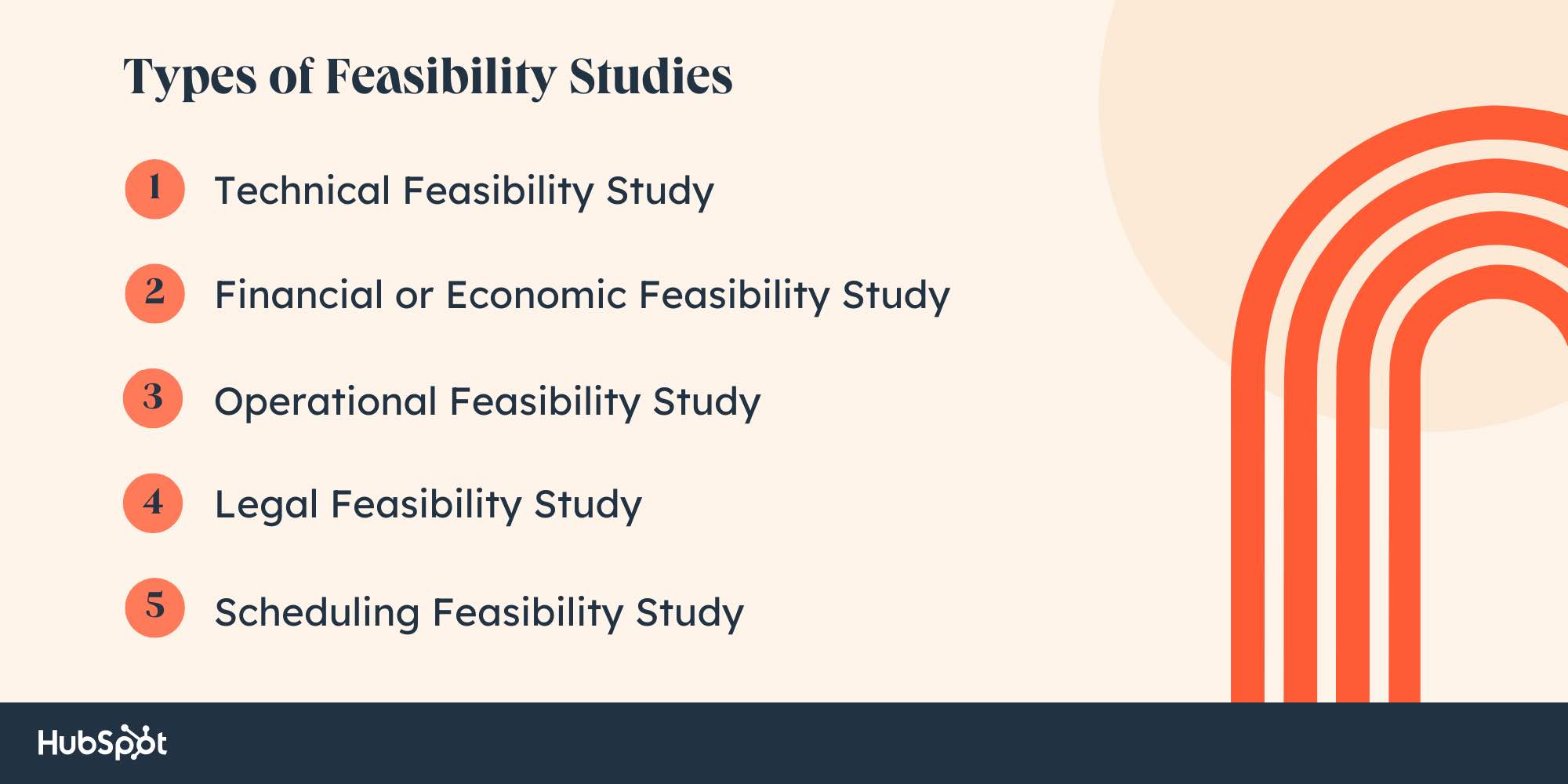
Technical Feasibility Study
A technical feasibility study looks at your project’s technical aspects. This type of study answers the question: do you have the specialized resources and capabilities to carry out this project?
You might have the appropriate funding for a project, but a technical feasibility study will help you determine if you have the right processes, systems, and staffing for the job.
Best for: Software development teams and project development teams
Financial or Economic Feasibility Study
Financial feasibility studies can help you determine if you have the funding for your project. Plus, you’ll learn the venture is an overall good investment for your team and your company. These kinds of feasibility studies ask: is the allotted funding amount appropriate for this project?
By completing a financial feasibility study, you’ll have already identified funding sources, expenses, your budget, any potential risks, and expected revenue.
Best for: Financial managers and project managers
Operational Feasibility Study
As the name suggests, an operational feasibility study analyzes whether or not your team is equipped to carry out the proposed plan or project. This feasibility study answers the questions:
- Does your team have the means to complete the project?
- Will the project add value for your team or your customers?
Consider conducting an operational feasibility study if you have developed a solution for a potential problem. This kind of study will help you determine if the solution solves the problem or creates more issues.
Best for: Project managers and stakeholders
Legal Feasibility Study
This feasibility study should be performed to determine if your proposed project is legal and ethical. Legal feasibility studies are designed to keep you and your team aligned with local, state, and federal laws.
If you are unsure if your project is unethical or unlawful, a legal feasibility study will help you make the appropriate decision before you begin.
Best for: Legal departments and project managers
Scheduling Feasibility Study
When starting a new project, you’ll often be asked, “When can we reasonably expect this project to be completed?”
If you and your team are working for clients and are on a deadline, a scheduling feasibility study looks at the project’s timeline. That can help your team determine a reasonable completion date.
After completing a scheduling feasibility study, you might find the plan requires more time than you thought. This is helpful to know before you begin a project.
Best for: Stakeholders, project managers, and their teams
If you are wondering how to write a feasibility study, look no further than our feasibility study template .
Before you jump into writing your own study with our feasibility study template, take a minute to familiarize yourself with each section of the template. Keep in mind, the feasibility study temple can be customized to fit the needs of you and your team.
1. Executive Summary
Your executive summary should be a one-page summary of the entire study. Make sure to include the following:
- The project name.
- A description of the project.
- The goals of the project or plan.
- The target market.
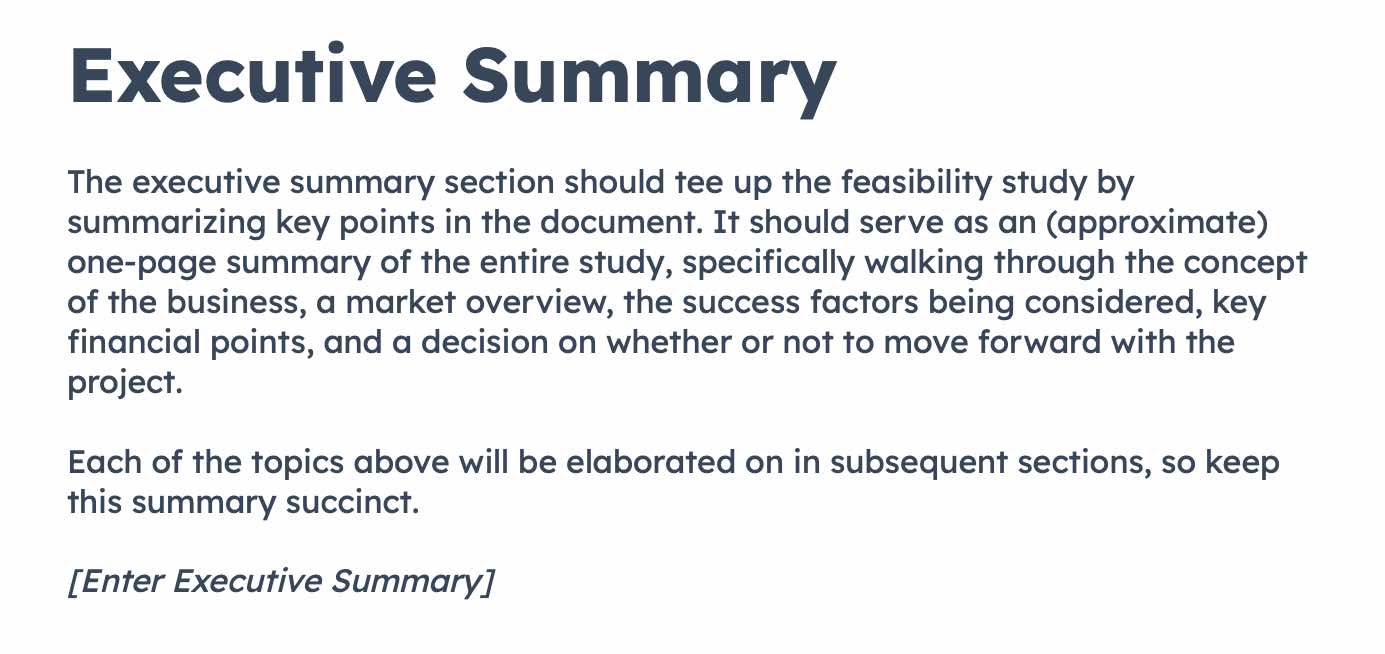
Image Source
2. Business Explanation
This section of the feasibility study is your space to introduce the business concept of your project or plan. Consider discussing:
- The purpose of the project or plan.
- Products or services.
- Competitive advantages.
- Experience of its founders.
If your project is feasible, you’ll want to be as specific as possible in this section and discuss the project’s projected success.
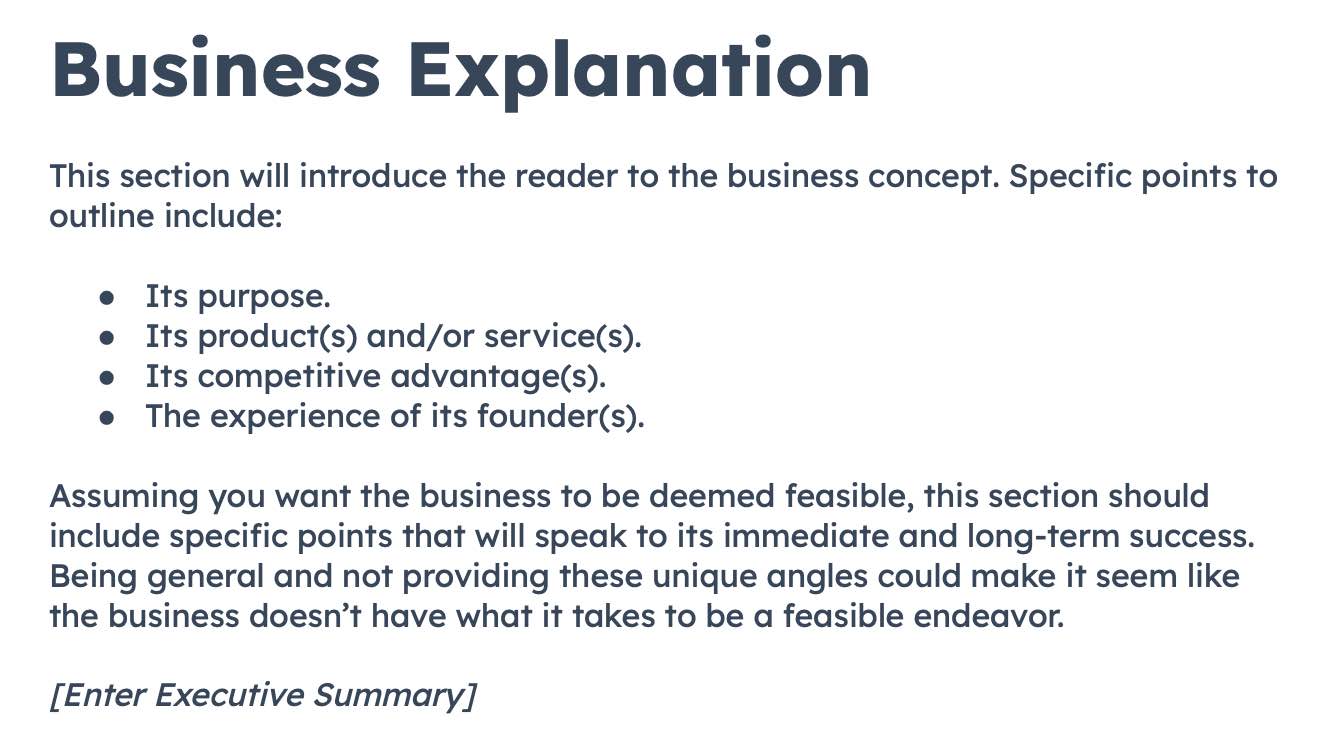
3. Market Overview
This section of your feasibility study should discuss your target market and why your project or plan will (or will not) succeed. You’ll want to discuss your target market in-depth, its pain points, and how your proposed product or service will solve the problems.
You’ll want to include valid data in this section. Consider featuring:
- The market size and demographics.
- The market psychographics.
- Competitors and substitutes.
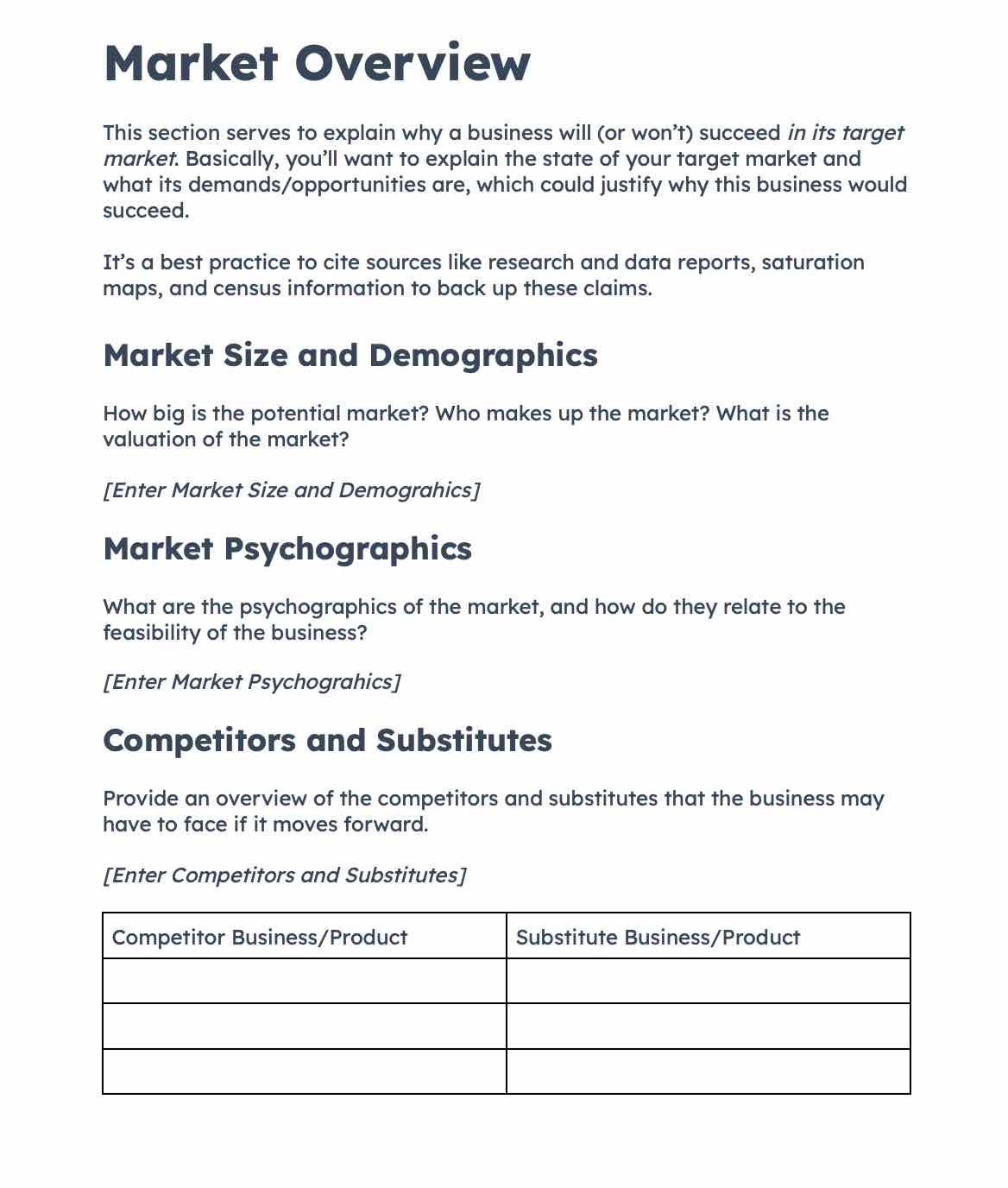
4. Financial Projections
Every good business endeavor is meant to make a profit. Your feasibility study should determine if the project or plan is a financially wise investment. The financial projections section of the feasibility template outlines and discusses critical financial metrics.
Considering including and discussing:
- Capital needs.
- Projected revenue and expenses.
- Projected revenue needed to break even.
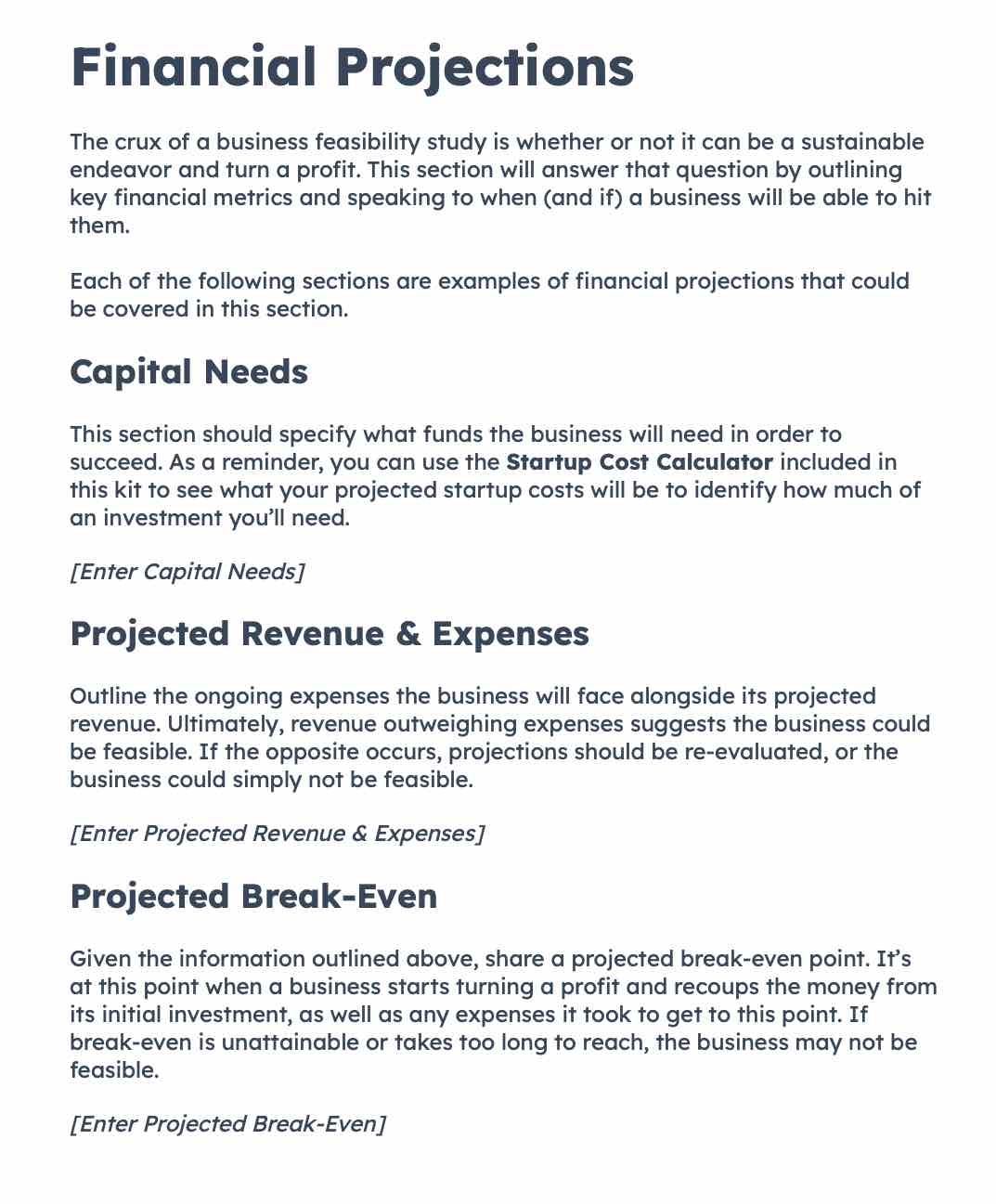
5. Feasibility Assessment and Conclusion
In your conclusion, be as clear and specific about your proposed project or plan as possible. Use statements like, “Based on our assessment of (X), we have deemed this business project feasible.”
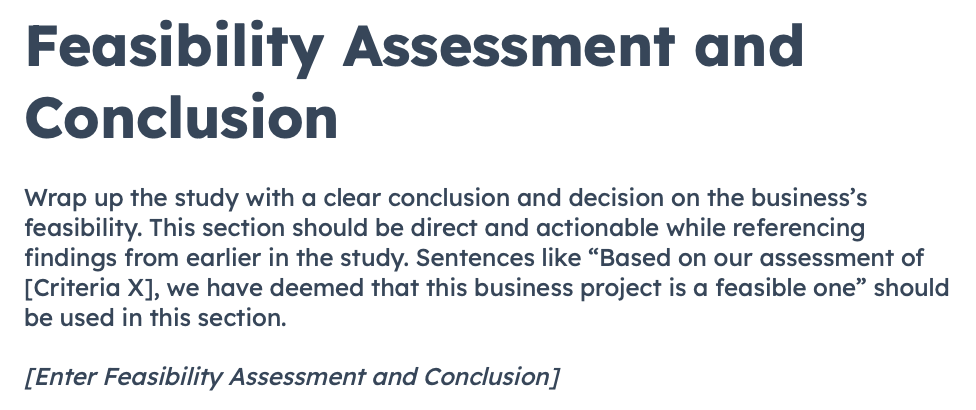
Feasibility studies can be helpful across your entire organization — from the sales team to the product development team. Here are a few examples of feasibility studies conducted in various industries.
Howard County Public School System
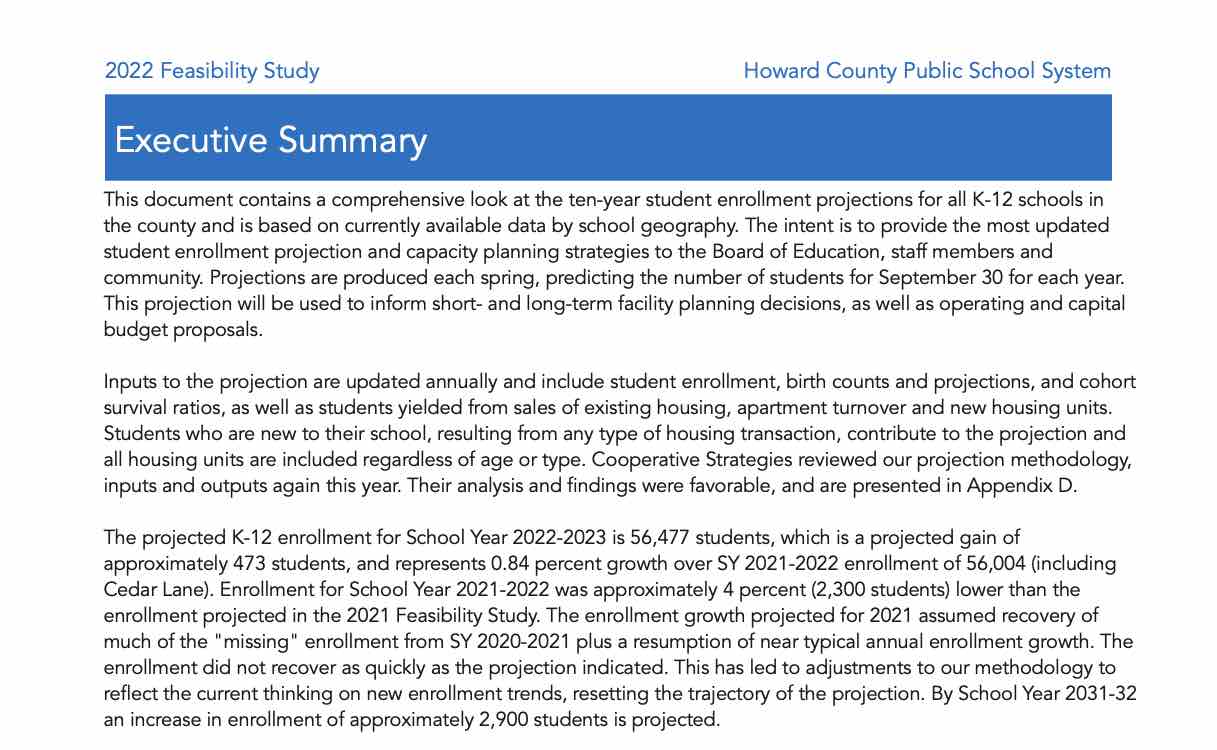
The Howard County Public School System’s feasibility study dives into projected student enrollment over a 10-year period.
What we love: The school system offers an excellent example of a brief, but thorough, executive summary. In this section, Howard County Public Schools also includes specific historical data used throughout the study.
Town of Walpole, Massachusetts
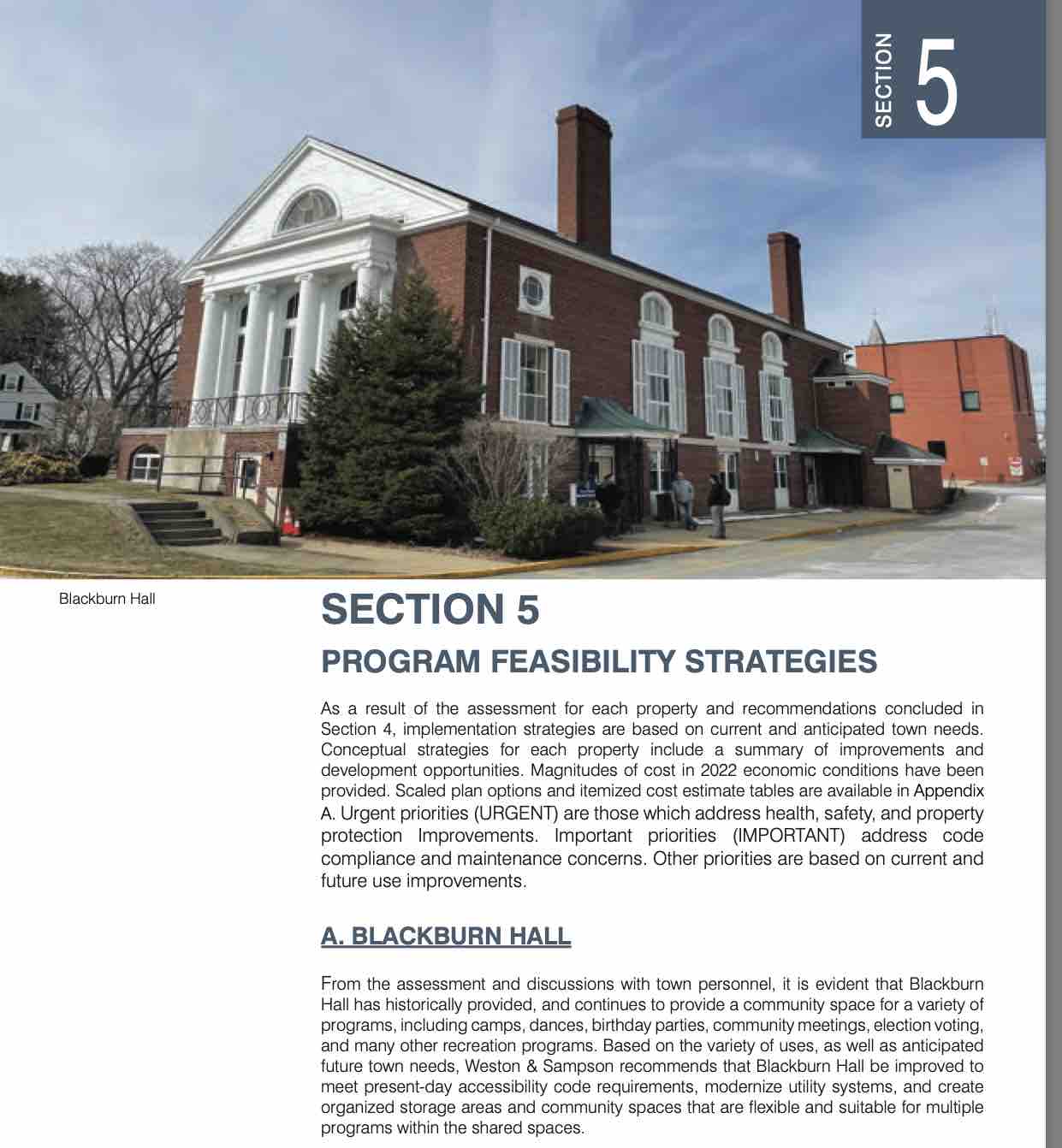
This feasibility study from the Walpole, Massachusetts’ explores the town’s recreation programming and facilities. Throughout, the document includes program recommendations with data that explains how the researchers came to this conclusion.
What we love: This document combines several different types of feasibility studies (financial, technical, and operational) into one comprehensive study. Remember, you can mold your feasibility study to fit your organization’s needs best.
U.S. Fish and Wildlife Service
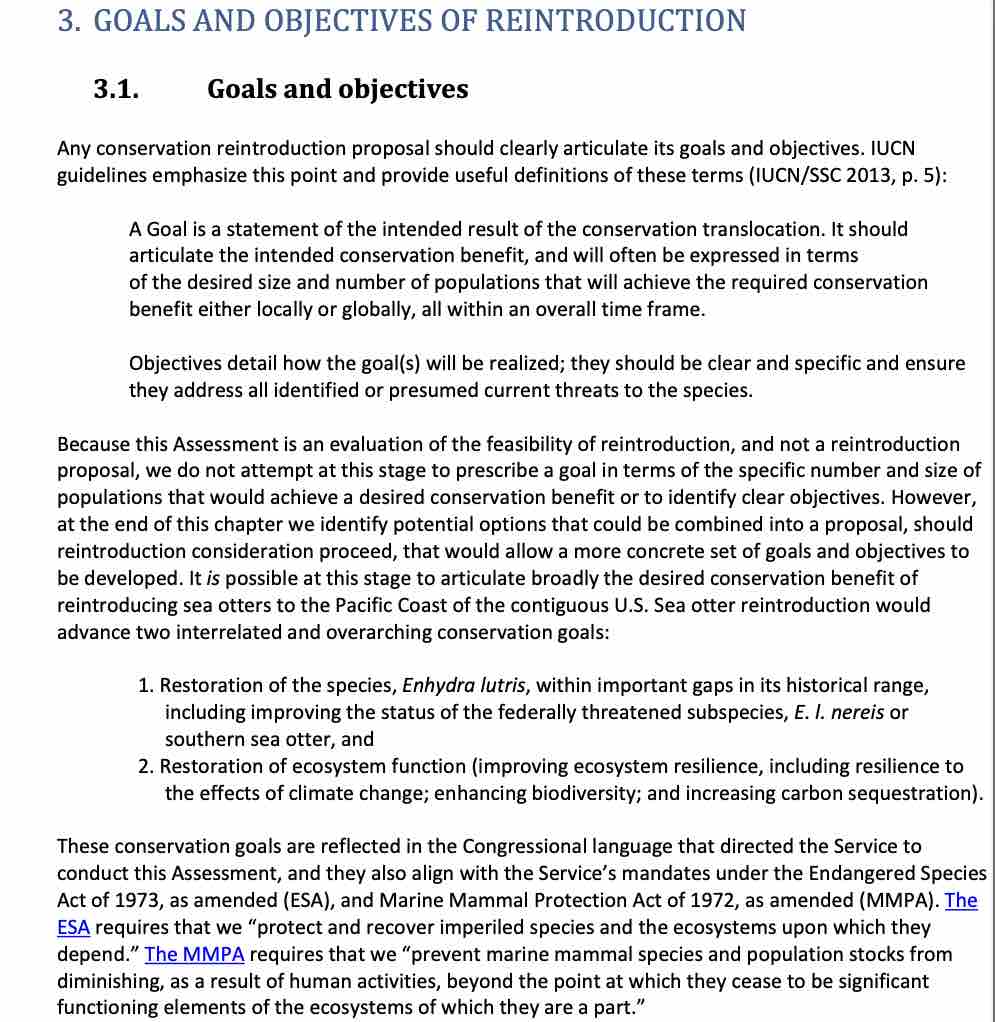
In this example, the U.S. Fish and Wildlife Service explores the feasibility of reintroducing sea otters to areas of the Pacific coast. This study also provides a model for structuring the objectives section of this document. A good feasibility study is clear and to the point in each section.
What we love: Here, the U.S. Fish and Wildlife Service distinguishes what the study covers (potential options for reintroduction), and what it cannot accomplish (projected population growth from reintroduction).
While your feasibility study seeks to assess a project’s viability, your document will have a limited scope. If you’ll need to gather additional information moving forward, mention that in your feasibility study.
Holdrege Area Public Library
Your feasibility study doesn’t need to be all text. The Holdrege Area Public Library makes use of graphics and charts to convey information in its feasibility study.
What we love: Infographics are easy to read. You can absorb important information with a quick skim.
Running Your Feasibility Study
Accurately predicting the success of a project might seem like a daunting task. But it doesn’t have to be. There are many ways to conduct a feasibility study. Stary by leveraging the tools you already have, like HubSpot’s Forecasting Software and our feasibility study template.
Your job as a sales leader is to help your team increase your organization’s bottom line. With the use of sales forecasting data and feasibility studies, you’ll be able to pursue the projects that will yield the highest ROI.
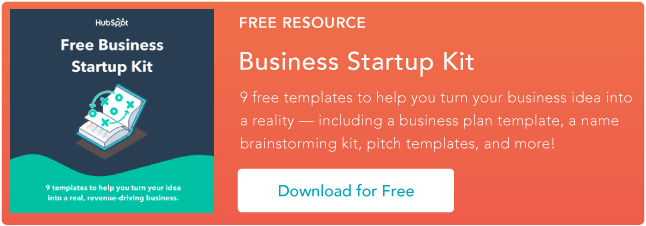
Don't forget to share this post!
Related articles.

Entrepreneurial Competency: What it Is & Why it Matters

3 Ways to Cash In on Golf's Takeover by Millennials and Gen Z

This YouTuber Makes $300k A Year Teaching People How to Sew

The $6.8B Sewing Boom Is Here to Stay — 3 Ways to Take Your Cut

Vagus Nerve Care: A $483 Million Health Trend You Need to Know About

A $40m Startup's Founder Shares Insights on Growth and Raising Capital

3 Ways to Build for The Rise (And Fall) of Businesses

8+ Opportunities to Capitalize on The Legal Tech Boom

Top Industries for Entrepreneurs in 2024 According to Our Trends Team

3 Lucrative Ways to Help Seniors Live That Fit and Fabulous Lifestyle
A free template to help you prove your project's feasibility.
Powerful and easy-to-use sales software that drives productivity, enables customer connection, and supports growing sales orgs
Free Financial Templates for a Business Plan
By Andy Marker | July 29, 2020
- Share on Facebook
- Share on LinkedIn
Link copied
In this article, we’ve rounded up expert-tested financial templates for your business plan, all of which are free to download in Excel, Google Sheets, and PDF formats.
Included on this page, you’ll find the essential financial statement templates, including income statement templates , cash flow statement templates , and balance sheet templates . Plus, we cover the key elements of the financial section of a business plan .
Financial Plan Templates
Download and prepare these financial plan templates to include in your business plan. Use historical data and future projections to produce an overview of the financial health of your organization to support your business plan and gain buy-in from stakeholders
Business Financial Plan Template

Use this financial plan template to organize and prepare the financial section of your business plan. This customizable template has room to provide a financial overview, any important assumptions, key financial indicators and ratios, a break-even analysis, and pro forma financial statements to share key financial data with potential investors.
Download Financial Plan Template
Word | PDF | Smartsheet
Financial Plan Projections Template for Startups

This financial plan projections template comes as a set of pro forma templates designed to help startups. The template set includes a 12-month profit and loss statement, a balance sheet, and a cash flow statement for you to detail the current and projected financial position of a business.
Download Startup Financial Projections Template
Excel | Smartsheet
Income Statement Templates for Business Plan
Also called profit and loss statements , these income statement templates will empower you to make critical business decisions by providing insight into your company, as well as illustrating the projected profitability associated with business activities. The numbers prepared in your income statement directly influence the cash flow and balance sheet forecasts.
Pro Forma Income Statement/Profit and Loss Sample

Use this pro forma income statement template to project income and expenses over a three-year time period. Pro forma income statements consider historical or market analysis data to calculate the estimated sales, cost of sales, profits, and more.
Download Pro Forma Income Statement Sample - Excel
Small Business Profit and Loss Statement

Small businesses can use this simple profit and loss statement template to project income and expenses for a specific time period. Enter expected income, cost of goods sold, and business expenses, and the built-in formulas will automatically calculate the net income.
Download Small Business Profit and Loss Template - Excel
3-Year Income Statement Template

Use this income statement template to calculate and assess the profit and loss generated by your business over three years. This template provides room to enter revenue and expenses associated with operating your business and allows you to track performance over time.
Download 3-Year Income Statement Template
For additional resources, including how to use profit and loss statements, visit “ Download Free Profit and Loss Templates .”
Cash Flow Statement Templates for Business Plan
Use these free cash flow statement templates to convey how efficiently your company manages the inflow and outflow of money. Use a cash flow statement to analyze the availability of liquid assets and your company’s ability to grow and sustain itself long term.
Simple Cash Flow Template

Use this basic cash flow template to compare your business cash flows against different time periods. Enter the beginning balance of cash on hand, and then detail itemized cash receipts, payments, costs of goods sold, and expenses. Once you enter those values, the built-in formulas will calculate total cash payments, net cash change, and the month ending cash position.
Download Simple Cash Flow Template
12-Month Cash Flow Forecast Template

Use this cash flow forecast template, also called a pro forma cash flow template, to track and compare expected and actual cash flow outcomes on a monthly and yearly basis. Enter the cash on hand at the beginning of each month, and then add the cash receipts (from customers, issuance of stock, and other operations). Finally, add the cash paid out (purchases made, wage expenses, and other cash outflow). Once you enter those values, the built-in formulas will calculate your cash position for each month with.
Download 12-Month Cash Flow Forecast
3-Year Cash Flow Statement Template Set

Use this cash flow statement template set to analyze the amount of cash your company has compared to its expenses and liabilities. This template set contains a tab to create a monthly cash flow statement, a yearly cash flow statement, and a three-year cash flow statement to track cash flow for the operating, investing, and financing activities of your business.
Download 3-Year Cash Flow Statement Template
For additional information on managing your cash flow, including how to create a cash flow forecast, visit “ Free Cash Flow Statement Templates .”

Balance Sheet Templates for a Business Plan
Use these free balance sheet templates to convey the financial position of your business during a specific time period to potential investors and stakeholders.
Small Business Pro Forma Balance Sheet

Small businesses can use this pro forma balance sheet template to project account balances for assets, liabilities, and equity for a designated period. Established businesses can use this template (and its built-in formulas) to calculate key financial ratios, including working capital.
Download Pro Forma Balance Sheet Template
Monthly and Quarterly Balance Sheet Template

Use this balance sheet template to evaluate your company’s financial health on a monthly, quarterly, and annual basis. You can also use this template to project your financial position for a specified time in the future. Once you complete the balance sheet, you can compare and analyze your assets, liabilities, and equity on a quarter-over-quarter or year-over-year basis.
Download Monthly/Quarterly Balance Sheet Template - Excel
Yearly Balance Sheet Template

Use this balance sheet template to compare your company’s short and long-term assets, liabilities, and equity year-over-year. This template also provides calculations for common financial ratios with built-in formulas, so you can use it to evaluate account balances annually.
Download Yearly Balance Sheet Template - Excel
For more downloadable resources for a wide range of organizations, visit “ Free Balance Sheet Templates .”
Sales Forecast Templates for Business Plan
Sales projections are a fundamental part of a business plan, and should support all other components of your plan, including your market analysis, product offerings, and marketing plan . Use these sales forecast templates to estimate future sales, and ensure the numbers align with the sales numbers provided in your income statement.
Basic Sales Forecast Sample Template

Use this basic forecast template to project the sales of a specific product. Gather historical and industry sales data to generate monthly and yearly estimates of the number of units sold and the price per unit. Then, the pre-built formulas will calculate percentages automatically. You’ll also find details about which months provide the highest sales percentage, and the percentage change in sales month-over-month.
Download Basic Sales Forecast Sample Template
12-Month Sales Forecast Template for Multiple Products

Use this sales forecast template to project the future sales of a business across multiple products or services over the course of a year. Enter your estimated monthly sales, and the built-in formulas will calculate annual totals. There is also space to record and track year-over-year sales, so you can pinpoint sales trends.
Download 12-Month Sales Forecasting Template for Multiple Products
3-Year Sales Forecast Template for Multiple Products

Use this sales forecast template to estimate the monthly and yearly sales for multiple products over a three-year period. Enter the monthly units sold, unit costs, and unit price. Once you enter those values, built-in formulas will automatically calculate revenue, margin per unit, and gross profit. This template also provides bar charts and line graphs to visually display sales and gross profit year over year.
Download 3-Year Sales Forecast Template - Excel
For a wider selection of resources to project your sales, visit “ Free Sales Forecasting Templates .”
Break-Even Analysis Template for Business Plan
A break-even analysis will help you ascertain the point at which a business, product, or service will become profitable. This analysis uses a calculation to pinpoint the number of service or unit sales you need to make to cover costs and make a profit.
Break-Even Analysis Template

Use this break-even analysis template to calculate the number of sales needed to become profitable. Enter the product's selling price at the top of the template, and then add the fixed and variable costs. Once you enter those values, the built-in formulas will calculate the total variable cost, the contribution margin, and break-even units and sales values.
Download Break-Even Analysis Template
For additional resources, visit, “ Free Financial Planning Templates .”
Business Budget Templates for Business Plan
These business budget templates will help you track costs (e.g., fixed and variable) and expenses (e.g., one-time and recurring) associated with starting and running a business. Having a detailed budget enables you to make sound strategic decisions, and should align with the expense values listed on your income statement.
Startup Budget Template

Use this startup budget template to track estimated and actual costs and expenses for various business categories, including administrative, marketing, labor, and other office costs. There is also room to provide funding estimates from investors, banks, and other sources to get a detailed view of the resources you need to start and operate your business.
Download Startup Budget Template
Small Business Budget Template

This business budget template is ideal for small businesses that want to record estimated revenue and expenditures on a monthly and yearly basis. This customizable template comes with a tab to list income, expenses, and a cash flow recording to track cash transactions and balances.
Download Small Business Budget Template
Professional Business Budget Template

Established organizations will appreciate this customizable business budget template, which contains a separate tab to track projected business expenses, actual business expenses, variances, and an expense analysis. Once you enter projected and actual expenses, the built-in formulas will automatically calculate expense variances and populate the included visual charts.
Download Professional Business Budget Template
For additional resources to plan and track your business costs and expenses, visit “ Free Business Budget Templates for Any Company .”
Other Financial Templates for Business Plan
In this section, you’ll find additional financial templates that you may want to include as part of your larger business plan.
Startup Funding Requirements Template

This simple startup funding requirements template is useful for startups and small businesses that require funding to get business off the ground. The numbers generated in this template should align with those in your financial projections, and should detail the allocation of acquired capital to various startup expenses.
Download Startup Funding Requirements Template - Excel
Personnel Plan Template

Use this customizable personnel plan template to map out the current and future staff needed to get — and keep — the business running. This information belongs in the personnel section of a business plan, and details the job title, amount of pay, and hiring timeline for each position. This template calculates the monthly and yearly expenses associated with each role using built-in formulas. Additionally, you can add an organizational chart to provide a visual overview of the company’s structure.
Download Personnel Plan Template - Excel
Elements of the Financial Section of a Business Plan
Whether your organization is a startup, a small business, or an enterprise, the financial plan is the cornerstone of any business plan. The financial section should demonstrate the feasibility and profitability of your idea and should support all other aspects of the business plan.
Below, you’ll find a quick overview of the components of a solid financial plan.
- Financial Overview: This section provides a brief summary of the financial section, and includes key takeaways of the financial statements. If you prefer, you can also add a brief description of each statement in the respective statement’s section.
- Key Assumptions: This component details the basis for your financial projections, including tax and interest rates, economic climate, and other critical, underlying factors.
- Break-Even Analysis: This calculation helps establish the selling price of a product or service, and determines when a product or service should become profitable.
- Pro Forma Income Statement: Also known as a profit and loss statement, this section details the sales, cost of sales, profitability, and other vital financial information to stakeholders.
- Pro Forma Cash Flow Statement: This area outlines the projected cash inflows and outflows the business expects to generate from operating, financing, and investing activities during a specific timeframe.
- Pro Forma Balance Sheet: This document conveys how your business plans to manage assets, including receivables and inventory.
- Key Financial Indicators and Ratios: In this section, highlight key financial indicators and ratios extracted from financial statements that bankers, analysts, and investors can use to evaluate the financial health and position of your business.
Need help putting together the rest of your business plan? Check out our free simple business plan templates to get started. You can learn how to write a successful simple business plan here .
Visit this free non-profit business plan template roundup or download a fill-in-the-blank business plan template to make things easy. If you are looking for a business plan template by file type, visit our pages dedicated specifically to Microsoft Excel , Microsoft Word , and Adobe PDF business plan templates. Read our articles offering startup business plan templates or free 30-60-90-day business plan templates to find more tailored options.
Discover a Better Way to Manage Business Plan Financials and Finance Operations
Empower your people to go above and beyond with a flexible platform designed to match the needs of your team — and adapt as those needs change.
The Smartsheet platform makes it easy to plan, capture, manage, and report on work from anywhere, helping your team be more effective and get more done. Report on key metrics and get real-time visibility into work as it happens with roll-up reports, dashboards, and automated workflows built to keep your team connected and informed.
When teams have clarity into the work getting done, there’s no telling how much more they can accomplish in the same amount of time. Try Smartsheet for free, today.
Discover why over 90% of Fortune 100 companies trust Smartsheet to get work done.
11.3 Conducting a Feasibility Analysis
Learning objectives.
By the end of this section, you will be able to:
- Describe the purpose of a feasibility analysis
- Describe and develop the parts of a feasibility analysis
- Understand how to apply feasibility outcomes to a new venture
As the name suggests, a feasibility analysis is designed to assess whether your entrepreneurial endeavor is, in fact, feasible or possible. By evaluating your management team, assessing the market for your concept, estimating financial viability, and identifying potential pitfalls, you can make an informed choice about the achievability of your entrepreneurial endeavor. A feasibility analysis is largely numbers driven and can be far more in depth than a business plan (discussed in The Business Plan ). It ultimately tests the viability of an idea, a project, or a new business. A feasibility study may become the basis for the business plan, which outlines the action steps necessary to take a proposal from ideation to realization. A feasibility study allows a business to address where and how it will operate, its competition, possible hurdles, and the funding needed to begin. The business plan then provides a framework that sets out a map for following through and executing on the entrepreneurial vision.
Organizational Feasibility Analysis
Organizational feasibility aims to assess the prowess of management and sufficiency of resources to bring a product or idea to market Figure 11.12 . The company should evaluate the ability of its management team on areas of interest and execution. Typical measures of management prowess include assessing the founders’ passion for the business idea along with industry expertise, educational background, and professional experience. Founders should be honest in their self-assessment of ranking these areas.
Resource sufficiency pertains to nonfinancial resources that the venture will need to move forward successfully and aims to assess whether an entrepreneur has a sufficient amount of such resources. The organization should critically rank its abilities in six to twelve types of such critical nonfinancial resources, such as availability of office space, quality of the labor pool, possibility of obtaining intellectual property protections (if applicable), willingness of high-quality employees to join the company, and likelihood of forming favorable strategic partnerships. If the analysis reveals that critical resources are lacking, the venture may not be possible as currently planned. 46
Financial Feasibility Analysis
A financial analysis seeks to project revenue and expenses (forecasts come later in the full business plan); project a financial narrative; and estimate project costs, valuations, and cash flow projections Figure 11.13 .
The financial analysis may typically include these items:
- A twelve-month profit and loss projection
- A three- or four-year profit-and-loss projection
- A cash-flow projection
- A projected balance sheet
- A breakeven calculation
The financial analysis should estimate the sales or revenue that you expect the business to generate. A number of different formulas and methods are available for calculating sales estimates. You can use industry or association data to estimate the sales of your potential new business. You can search for similar businesses in similar locations to gauge how your business might perform compared with similar performances by competitors. One commonly used equation for a sales model multiplies the number of target customers by the average revenue per customer to establish a sales projection:
Another critical part of planning for new business owners is to understand the breakeven point , which is the level of operations that results in exactly enough revenue to cover costs (see Entrepreneurial Finance and Accounting for an in-depth discussion on calculating breakeven points and the breakdown of cost types). It yields neither a profit nor a loss. To calculate the breakeven point, you must first understand the two types of costs: fixed and variable. Fixed costs are expenses that do not vary based on the amount of sales. Rent is one example, but most of a business’s other costs operate in this manner as well. While some costs vary from month to month, costs are described as variable only if they will increase if the company sells even one more item. Costs such as insurance, wages, and office supplies are typically considered fixed costs. Variable costs fluctuate with the level of sales revenue and include items such as raw materials, purchases to be sold, and direct labor. With this information, you can calculate your breakeven point—the sales level at which your business has neither a profit nor a loss. 47 Projections should be more than just numbers: include an explanation of the underlying assumptions used to estimate the venture’s income and expenses.
Projected cash flow outlines preliminary expenses, operating expenses, and reserves—in essence, how much you need before starting your company. You want to determine when you expect to receive cash and when you have to write a check for expenses. Your cash flow is designed to show if your working capital is adequate. A balance sheet shows assets and liabilities, necessary for reporting and financial management. When liabilities are subtracted from assets, the remainder is owners’ equity. The financial concepts and statements introduced here are discussed fully in Entrepreneurial Finance and Accounting .
Market Feasibility Analysis
A market analysis enables you to define competitors and quantify target customers and/or users in the market within your chosen industry by analyzing the overall interest in the product or service within the industry by its target market Figure 11.14 . You can define a market in terms of size, structure, growth prospects, trends, and sales potential. This information allows you to better position your company in competing for market share. After you’ve determined the overall size of the market, you can define your target market, which leads to a total available market (TAM) , that is, the number of potential users within your business’s sphere of influence. This market can be segmented by geography, customer attributes, or product-oriented segments. From the TAM, you can further distill the portion of that target market that will be attracted to your business. This market segment is known as a serviceable available market (SAM) .
Projecting market share can be a subjective estimate, based not only on an analysis of the market but also on pricing, promotional, and distribution strategies. As is the case for revenue, you will have a number of different forecasts and tools available at your disposal. Other items you may include in a market analysis are a complete competitive review, historical market performance, changes to supply and demand, and projected growth in demand over time.
Are You Ready?
You’ve been hired by a leading hotel chain to determine the market and financial potential for the development of a mixed-use property that will include a full-service hotel in downtown Orlando, located at 425 East Central Boulevard, in Orlando, Florida. The specific address is important so you can pinpoint existing competitors and overall suitability of the site. Using the information given, conduct a market analysis that can be part of a larger feasibility study.
Work It Out
Location feasibility.
You’re considering opening a boutique clothing store in downtown Atlanta. You’ve read news reports about how downtown Atlanta and the city itself are growing and undergoing changes from previous decades. With new development taking place there, you’re not sure whether such a venture is viable. Outline what steps you would need to take to conduct a feasibility study to determine whether downtown Atlanta is the right location for your planned clothing store.
Applying Feasibility Outcomes
After conducting a feasibility analysis, you must determine whether to proceed with the venture. One technique that is commonly used in project management is known as a go-or-no-go decision . This tool allows a team to decide if criteria have been met to move forward on a project. Criteria on which to base a decision are established and tracked over time. You can develop criteria for each section of the feasibility analysis to determine whether to proceed and evaluate those criteria as either “go” or “no go,” using that assessment to make a final determination of the overall concept feasibility. Determine whether you are comfortable proceeding with the present management team, whether you can “go” forward with existing nonfinancial resources, whether the projected financial outlook is worth proceeding, and make a determination on the market and industry. If satisfied that enough “go” criteria are met, you would likely then proceed to developing your strategy in the form of a business plan.
What Can You Do?
Love beyond walls.
When Terence Lester saw a homeless man living behind an abandoned, dilapidated building, he asked the man if he could take him to a shelter. The man scoffed, replying that Lester should sleep in a shelter. So he did—and he saw the problem through the homeless man’s perspective. The shelter was crowded and smelly. You couldn’t get much sleep, because others would try to steal your meager belongings. The dilapidated building provided isolation away from others, but quiet and security in its own way that the shelter could not. This experience led Lester to voluntarily live as a homeless person for a few weeks. His journey led him to create Love Beyond Walls (www.lovebeyondwalls.org), an organization that aids the homeless, among other causes. Lester didn’t conduct a formal feasibility study, but he did so informally by walking in his intended customers’ shoes—literally. A feasibility study of homelessness in a particular area could yield surprising findings that might lead to social entrepreneurial pursuits.
- What is a social cause you think could benefit from a formal feasibility study around a potential entrepreneurial solution?
- 46 Ulrich Kaiser. “A primer in Entrepreneurship – Chapter 3 Feasibility analysis” University of Zurich Institute for Strategy and Business Economics . n.d. https://docplayer.net/7775267-A-primer-in-entrepreneurship-chapter-3-feasibility-analysis.html
- 47 In a preliminary financial model and business plan, startup costs should be allocated, as they are intended for one-time investments in development; pre-launch costs and other necessary expenses will not carry over once the product/solution has launched.
As an Amazon Associate we earn from qualifying purchases.
This book may not be used in the training of large language models or otherwise be ingested into large language models or generative AI offerings without OpenStax's permission.
Want to cite, share, or modify this book? This book uses the Creative Commons Attribution License and you must attribute OpenStax.
Access for free at https://openstax.org/books/entrepreneurship/pages/1-introduction
- Authors: Michael Laverty, Chris Littel
- Publisher/website: OpenStax
- Book title: Entrepreneurship
- Publication date: Jan 16, 2020
- Location: Houston, Texas
- Book URL: https://openstax.org/books/entrepreneurship/pages/1-introduction
- Section URL: https://openstax.org/books/entrepreneurship/pages/11-3-conducting-a-feasibility-analysis
© Jan 4, 2024 OpenStax. Textbook content produced by OpenStax is licensed under a Creative Commons Attribution License . The OpenStax name, OpenStax logo, OpenStax book covers, OpenStax CNX name, and OpenStax CNX logo are not subject to the Creative Commons license and may not be reproduced without the prior and express written consent of Rice University.
- Search Search Please fill out this field.
What Is a Feasibility Study?
Understanding a feasibility study, how to conduct a feasibility study.
- Feasibility Study FAQs
The Bottom Line
- Business Essentials
Feasibility Study
:max_bytes(150000):strip_icc():format(webp)/Group1805-3b9f749674f0434184ef75020339bd35.jpg)
Yarilet Perez is an experienced multimedia journalist and fact-checker with a Master of Science in Journalism. She has worked in multiple cities covering breaking news, politics, education, and more. Her expertise is in personal finance and investing, and real estate.
:max_bytes(150000):strip_icc():format(webp)/YariletPerez-d2289cb01c3c4f2aabf79ce6057e5078.jpg)
A feasibility study is a detailed analysis that considers all of the critical aspects of a proposed project in order to determine the likelihood of it succeeding.
Success in business may be defined primarily by return on investment , meaning that the project will generate enough profit to justify the investment. However, many other important factors may be identified on the plus or minus side, such as community reaction and environmental impact.
Although feasibility studies can help project managers determine the risk and return of pursuing a plan of action, several steps should be considered before moving forward.
Key Takeaways
- A company may conduct a feasibility study when it's considering launching a new business, adding a new product line, or acquiring a rival.
- A feasibility study assesses the potential for success of the proposed plan or project by defining its expected costs and projected benefits in detail.
- It's a good idea to have a contingency plan on hand in case the original project is found to be infeasible.
Investopedia / Lara Antal
A feasibility study is an assessment of the practicality of a proposed plan or project. A feasibility study analyzes the viability of a project to determine whether the project or venture is likely to succeed. The study is also designed to identify potential issues and problems that could arise while pursuing the project.
As part of the feasibility study, project managers must determine whether they have enough of the right people, financial resources, and technology. The study must also determine the return on investment, whether this is measured as a financial gain or a benefit to society, as in the case of a nonprofit project.
The feasibility study might include a cash flow analysis, measuring the level of cash generated from revenue versus the project's operating costs . A risk assessment must also be completed to determine whether the return is enough to offset the risk of undergoing the venture.
When doing a feasibility study, it’s always good to have a contingency plan that is ready to test as a viable alternative if the first plan fails.
Benefits of a Feasibility Study
There are several benefits to feasibility studies, including helping project managers discern the pros and cons of undertaking a project before investing a significant amount of time and capital into it.
Feasibility studies can also provide a company's management team with crucial information that could prevent them from entering into a risky business venture.
Such studies help companies determine how they will grow. They will know more about how they will operate, what the potential obstacles are, who the competition is, and what the market is.
Feasibility studies also help convince investors and bankers that investing in a particular project or business is a wise choice.
The exact format of a feasibility study will depend on the type of organization that requires it. However, the same factors will be involved even if their weighting varies.
Preliminary Analysis
Although each project can have unique goals and needs, there are some best practices for conducting any feasibility study:
- Conduct a preliminary analysis, which involves getting feedback about the new concept from the appropriate stakeholders
- Analyze and ask questions about the data obtained in the early phase of the study to make sure that it's solid
- Conduct a market survey or market research to identify the market demand and opportunity for pursuing the project or business
- Write an organizational, operational, or business plan, including identifying the amount of labor needed, at what cost, and for how long
- Prepare a projected income statement, which includes revenue, operating costs, and profit
- Prepare an opening day balance sheet
- Identify obstacles and any potential vulnerabilities, as well as how to deal with them
- Make an initial "go" or "no-go" decision about moving ahead with the plan
Suggested Components
Once the initial due diligence has been completed, the real work begins. Components that are typically found in a feasibility study include the following:
- Executive summary : Formulate a narrative describing details of the project, product, service, plan, or business.
- Technological considerations : Ask what will it take. Do you have it? If not, can you get it? What will it cost?
- Existing marketplace : Examine the local and broader markets for the product, service, plan, or business.
- Marketing strategy : Describe it in detail.
- Required staffing : What are the human capital needs for this project? Draw up an organizational chart.
- Schedule and timeline : Include significant interim markers for the project's completion date.
- Project financials .
- Findings and recommendations : Break down into subsets of technology, marketing, organization, and financials.
Examples of a Feasibility Study
Below are two examples of a feasibility study. The first involves expansion plans for a university. The second is a real-world example conducted by the Washington State Department of Transportation with private contributions from Microsoft Inc.
A University Science Building
Officials at a university were concerned that the science building—built in the 1970s—was outdated. Considering the technological and scientific advances of the last 20 years, they wanted to explore the cost and benefits of upgrading and expanding the building. A feasibility study was conducted.
In the preliminary analysis, school officials explored several options, weighing the benefits and costs of expanding and updating the science building. Some school officials had concerns about the project, including the cost and possible community opposition. The new science building would be much larger, and the community board had earlier rejected similar proposals. The feasibility study would need to address these concerns and any potential legal or zoning issues.
The feasibility study also explored the technological needs of the new science facility, the benefits to the students, and the long-term viability of the college. A modernized science facility would expand the school's scientific research capabilities, improve its curriculum, and attract new students.
Financial projections showed the cost and scope of the project and how the school planned to raise the needed funds, which included issuing a bond to investors and tapping into the school's endowment . The projections also showed how the expanded facility would allow more students to be enrolled in the science programs, increasing revenue from tuition and fees.
The feasibility study demonstrated that the project was viable, paving the way to enacting the modernization and expansion plans of the science building.
Without conducting a feasibility study, the school administrators would never have known whether its expansion plans were viable.
A High-Speed Rail Project
The Washington State Department of Transportation decided to conduct a feasibility study on a proposal to construct a high-speed rail that would connect Vancouver, British Columbia, Seattle, Washington, and Portland, Oregon. The goal was to create an environmentally responsible transportation system to enhance the competitiveness and future prosperity of the Pacific Northwest.
The preliminary analysis outlined a governance framework for future decision-making. The study involved researching the most effective governance framework by interviewing experts and stakeholders, reviewing governance structures, and learning from existing high-speed rail projects in North America. As a result, governing and coordinating entities were developed to oversee and follow the project if it was approved by the state legislature.
A strategic engagement plan involved an equitable approach with the public, elected officials, federal agencies, business leaders, advocacy groups, and indigenous communities. The engagement plan was designed to be flexible, considering the size and scope of the project and how many cities and towns would be involved. A team of the executive committee members was formed and met to discuss strategies, lessons learned from previous projects and met with experts to create an outreach framework.
The financial component of the feasibility study outlined the strategy for securing the project's funding, which explored obtaining funds from federal, state, and private investments. The project's cost was estimated to be between $24 billion to $42 billion. The revenue generated from the high-speed rail system was estimated to be between $160 million and $250 million.
The report bifurcated the money sources between funding and financing. Funding referred to grants, appropriations from the local or state government, and revenue. Financing referred to bonds issued by the government, loans from financial institutions, and equity investments, which are essentially loans against future revenue that needs to be paid back with interest.
The sources for the capital needed were to vary as the project moved forward. In the early stages, most of the funding would come from the government, and as the project developed, funding would come from private contributions and financing measures. Private contributors included Microsoft Inc., which donated more than $570,000 to the project.
The benefits outlined in the feasibility report show that the region would experience enhanced interconnectivity, allowing for better management of the population and increasing regional economic growth by $355 billion. The new transportation system would provide people with access to better jobs and more affordable housing. The high-speed rail system would also relieve congested areas from automobile traffic.
The timeline for the study began in 2016 when an agreement was reached with British Columbia to work together on a new technology corridor that included high-speed rail transportation. The feasibility report was submitted to the Washington State land Legislature in December 2020.
What Is the Main Objective of a Feasibility Study?
A feasibility study is designed to help decision-makers determine whether or not a proposed project or investment is likely to be successful. It identifies both the known costs and the expected benefits.
In business, "successful" means that the financial return exceeds the cost. In a nonprofit, success may be measured in other ways. A project's benefit to the community it serves may be worth the cost.
What Are the Steps in a Feasibility Study?
A feasibility study starts with a preliminary analysis. Stakeholders are interviewed, market research is conducted, and a business plan is prepared. All of this information is analyzed to make an initial "go" or "no-go" decision.
If it's a go, the real study can begin. This includes listing the technological considerations, studying the marketplace, describing the marketing strategy, and outlining the necessary human capital, project schedule, and financing requirements.
Who Conducts a Feasibility Study?
A feasibility study may be conducted by a team of the organization's senior managers. If they lack the expertise or time to do the work internally it may be outsourced to a consultant.
What Are the 4 Types of Feasibility?
The study considers the feasibility of four aspects of a project:
Technical: A list of the hardware and software needed, and the skilled labor required to make them work.
Financial: An estimate of the cost of the overall project and its expected return.
Market: An analysis of the market for the product or service, the industry, competition, consumer demand, sales forecasts, and growth projections
Organizational: An outline of the business structure and the management team that will be needed.
Feasibility studies help project managers determine the viability of a project or business venture by identifying the factors that can lead to its success. The study also shows the potential return on investment and any risks to the success of the venture.
A feasibility study contains a detailed analysis of what's needed to complete the proposed project. The report may include a description of the new product or venture, a market analysis, the technology and labor needed, as well as the sources of financing and capital. The report will also include financial projections, the likelihood of success, and ultimately, a go-or-no-go decision.
Washington State Department of Transportation. " Ultra-High-Speed Rail Study ."
Washington State Department of Transportation. " Cascadia Ultra High Speed Ground Transportation Framework for the Future ."
Washington State Department of Transportation. " Ultra-High-Speed Rail Study: Outcomes ."
Washington State Department of Transportation. " Ultra-High-Speed Ground Transportation Business Case Analysis ." Page ii.
:max_bytes(150000):strip_icc():format(webp)/request-for-proposal.asp-V1-47ccaf79d2ed4a0eaec15c24a901c5f2.jpg)
- Terms of Service
- Editorial Policy
- Privacy Policy
- Your Privacy Choices

Financial Feasibility Report
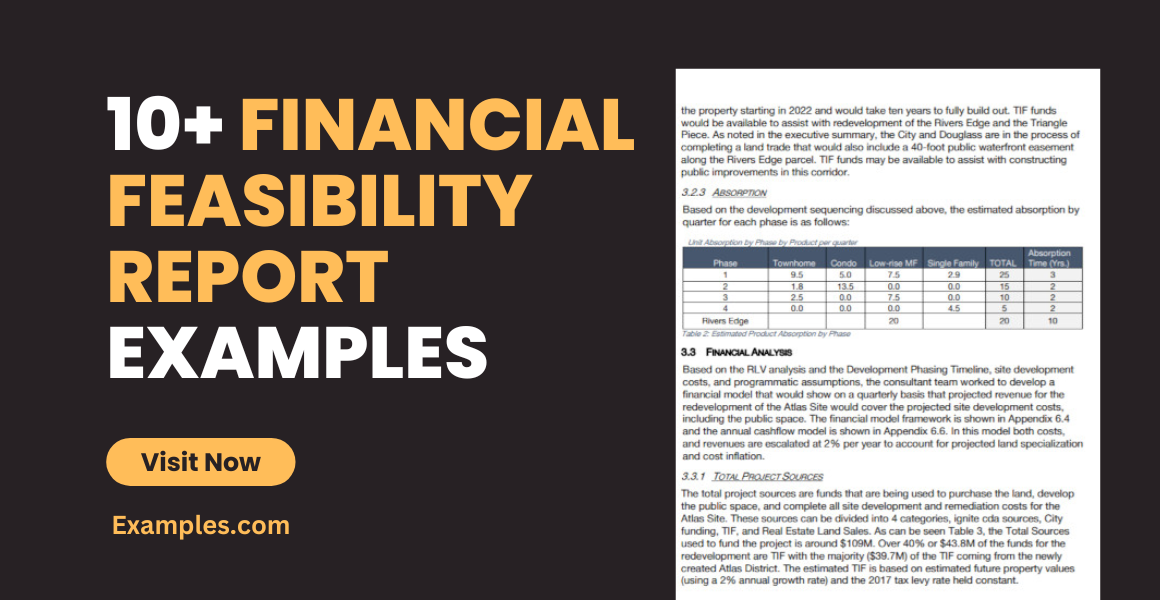
Many companies and businesses rely on the consistent improvement of their products and services to stay competitive in the marketplace. This means that said companies and businesses will require projects that will improve the whole structure of the company or business and their products and services. To know whether or not the project is viable, one must conduct and create a financial feasibility report.
10+ Financial Feasibility Report Examples
1. financial feasibility report template.

2. Standard Financial Feasibility Report

3. Professional Financial Feasibility Report
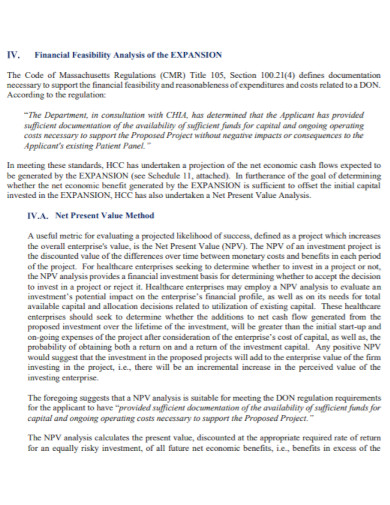
4. Financial Feasibility Study Report

5. Financial Feasibility Assessment Report

Size: 557 KB
6. Financial Operations Feasibility Report
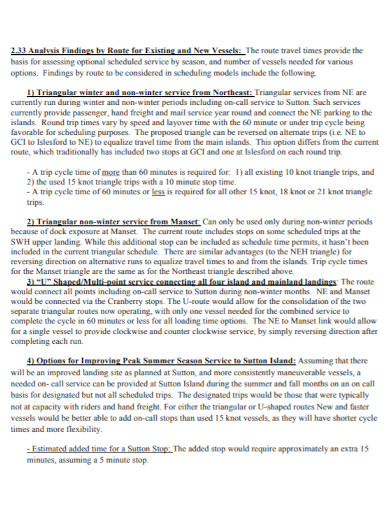
Size: 11 MB
7. Financial Feasibility Report Services

Size: 118 KB
8. Market and Financial Feasibility Report
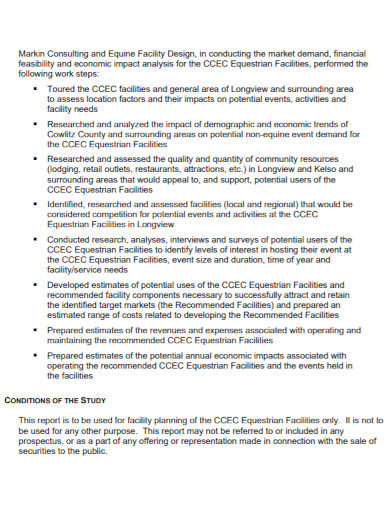
9. School Financial Feasibility Report
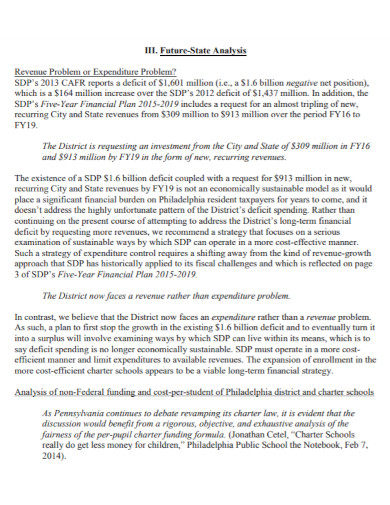
Size: 288 KB
10. Financial Feasibility Report in PDF
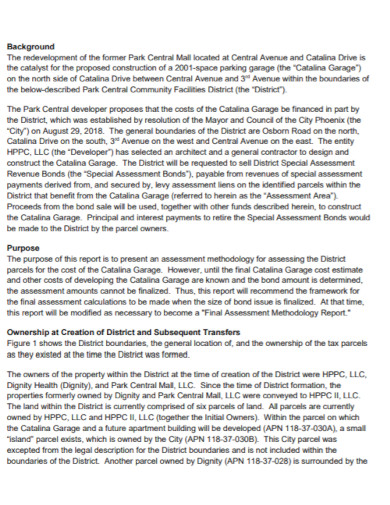
11. General Financial Feasibility Report

What Is a Financial Feasibility Report
A financial feasibility report is a document that will outline the financial availability and viability of a specific project. This report will succinctly detail the projected financial outcomes and costs the project might incur on the business or company conducting said project.
How to Write a Financial Feasibility Report
A standard financial feasibility report is a very long and important document that will take some time to finish writing. A well-written financial feasibility report will allow the upper management to have more confidence in the outcome and feasibility of the project. If you need to have a financial feasibility report template or an example, you may refer to any of the samples named Professional Financial Feasibility Report , Financial Feasibility Study Report , Financial Feasibility Assessment Report , and Financial Operations Feasibility Report .
Step 1: Conduct the Financial Feasibility Study
Begin by conducting the financial feasibility study as this will provide you with the initial data that you will write down in your report. If you do not know how to conduct a financial feasibility study, you may opt to have an expert conduct the study for you.
Step 2: Create The Cover Page, The Table of Contents, and the Introduction
The report must begin with a title page or a cover page that will preface all the contents of the financial feasibility report. The next page that will follow the cover page is the table of contents , which must indicate and label the location of each element of the feasibility report. Lastly, the introduction should come after the table of contents to set the stage and introduce the whole financial feasibility report.
Step 3: Write the Financial Feasibility
After you finish the first few pages, you must now write the financial feasibility of the project. This should include the projected income and expenses, which should be compared and juxtaposed against the resources available in the business or company.
Step 4: List Out the Details of The Market Survey
Another part that must be added to the financial feasibility report is the market study. This will determine if the market is ready for the results of the project, which will directly affect the projected ratio between income and expenses.
Step 5: Analyze the Data
You must analyze the data of both the financial feasibility and deduce the effects they will have on the likelihood of success of the said project. Not only that, but the data will also determine if the business can support the project’s lifespan.
Step 6: Write the Conclusion
The final portion of the financial feasibility report is to have a conclusive statement. This statement will close the whole report and indicate the future decision and actions one may take.
What is the purpose of the financial feasibility study?
Every project has stakeholders and shareholders that will provide the manpower, commodities , and resources needed to ensure a successful project. Like most things, these projects will cost a lot of money to sustain which will be pivotal for the success and longevity of the said project. The financial feasibility study is a research effort that experts do to determine whether or not the project has enough financial resources (money and assets) to sustain the lifespan of the entire project. This research effort is very important as it will dictate whether or not the business or company can undertake the efforts the project requires from them without the risk of bankruptcy or longstanding issues that will cripple the project or the business conducting the said project. For example, if a storage business wants to conduct a project to increase the number of its warehouses, it must determine if they have enough materials and money to fund the project they want to do. Therefore if one wants to conduct a project that will increase one’s sales, quality of product and/or service , or sales, then the business or company should conduct a financial feasibility study for their project.
What is the main objective of a financial feasibility study?
The main objective or goal of the financially feasible study is to determine or check the viability of the project when it is compared to the financial resources the business or company has available for the project. Not only will the financial feasibility study generate a report for one to use as a reference, but the upper management will also be able to make informed decisions. Therefore, it is very important for the upper management to either conduct or requests a financial feasibility study for their future projects.
How do you analyze financial feasibility reports?
The financial feasibility study generates a report that will have various data points the financial experts will use to determine the viability of the project. The first thing one should do is to analyze the projected income and expenditure, that the financial feasibility study will generate. After analyzing the data, one must check if there is a customer or consumer demand for the outcome of the project, or if the project will appease a specific customer demand. Afterward, you must determine if any person or outside labor is needed for the project, and whether or not the business or company can allocate said resources to the project. The last step of the analysis of one’s financial feasibility report is to create or brainstorm an informed decision for the future of the project.
A financial feasibility report is a type of report that contains data people will use to determine the financial viability of the project. When a person creates a well-made financial feasibility report the people involved can create good decisions that will not jeopardize any element or aspect of a specific business or company. Therefore it is important to know how to create a financial feasibility report when proposing a project for a company.
Report Generator
Text prompt
- Instructive
- Professional
Generate a report on the impact of technology in the classroom on student learning outcomes
Prepare a report analyzing the trends in student participation in sports and arts programs over the last five years at your school.

- school Campus Bookshelves
- menu_book Bookshelves
- perm_media Learning Objects
- login Login
- how_to_reg Request Instructor Account
- hub Instructor Commons
- Download Page (PDF)
- Download Full Book (PDF)
- Periodic Table
- Physics Constants
- Scientific Calculator
- Reference & Cite
- Tools expand_more
- Readability
selected template will load here
This action is not available.

5.1.4: Conducting a Feasibility Analysis
- Last updated
- Save as PDF
- Page ID 73815
\( \newcommand{\vecs}[1]{\overset { \scriptstyle \rightharpoonup} {\mathbf{#1}} } \)
\( \newcommand{\vecd}[1]{\overset{-\!-\!\rightharpoonup}{\vphantom{a}\smash {#1}}} \)
\( \newcommand{\id}{\mathrm{id}}\) \( \newcommand{\Span}{\mathrm{span}}\)
( \newcommand{\kernel}{\mathrm{null}\,}\) \( \newcommand{\range}{\mathrm{range}\,}\)
\( \newcommand{\RealPart}{\mathrm{Re}}\) \( \newcommand{\ImaginaryPart}{\mathrm{Im}}\)
\( \newcommand{\Argument}{\mathrm{Arg}}\) \( \newcommand{\norm}[1]{\| #1 \|}\)
\( \newcommand{\inner}[2]{\langle #1, #2 \rangle}\)
\( \newcommand{\Span}{\mathrm{span}}\)
\( \newcommand{\id}{\mathrm{id}}\)
\( \newcommand{\kernel}{\mathrm{null}\,}\)
\( \newcommand{\range}{\mathrm{range}\,}\)
\( \newcommand{\RealPart}{\mathrm{Re}}\)
\( \newcommand{\ImaginaryPart}{\mathrm{Im}}\)
\( \newcommand{\Argument}{\mathrm{Arg}}\)
\( \newcommand{\norm}[1]{\| #1 \|}\)
\( \newcommand{\Span}{\mathrm{span}}\) \( \newcommand{\AA}{\unicode[.8,0]{x212B}}\)
\( \newcommand{\vectorA}[1]{\vec{#1}} % arrow\)
\( \newcommand{\vectorAt}[1]{\vec{\text{#1}}} % arrow\)
\( \newcommand{\vectorB}[1]{\overset { \scriptstyle \rightharpoonup} {\mathbf{#1}} } \)
\( \newcommand{\vectorC}[1]{\textbf{#1}} \)
\( \newcommand{\vectorD}[1]{\overrightarrow{#1}} \)
\( \newcommand{\vectorDt}[1]{\overrightarrow{\text{#1}}} \)
\( \newcommand{\vectE}[1]{\overset{-\!-\!\rightharpoonup}{\vphantom{a}\smash{\mathbf {#1}}}} \)
Learning Objectives
By the end of this section, you will be able to:
- Describe the purpose of a feasibility analysis
- Describe and develop the parts of a feasibility analysis
- Understand how to apply feasibility outcomes to a new venture
As the name suggests, a feasibility analysis is designed to assess whether your entrepreneurial endeavor is, in fact, feasible or possible. By evaluating your management team, assessing the market for your concept, estimating financial viability, and identifying potential pitfalls, you can make an informed choice about the achievability of your entrepreneurial endeavor. A feasibility analysis is largely numbers-driven and can be far more in-depth than a business plan. It ultimately tests the viability of an idea, a project, or a new business. A feasibility study may become the basis for the business plan, which outlines the action steps necessary to take a proposal from ideation to realization. A feasibility study allows a business to address where and how it will operate, its competition, possible hurdles, and the funding needed to begin. The business plan then provides a framework that sets out a map for following through and executing the entrepreneurial vision.
Organizational Feasibility Analysis
Organizational feasibility aims to assess the prowess of management and sufficiency of resources to bring a product or idea to market Figure 5.1.4.1. The company should evaluate the ability of its management team on areas of interest and execution. Typical measures of management prowess include assessing the founders’ passion for the business idea along with industry expertise, educational background, and professional experience. Founders should be honest in their self-assessment of ranking these areas.
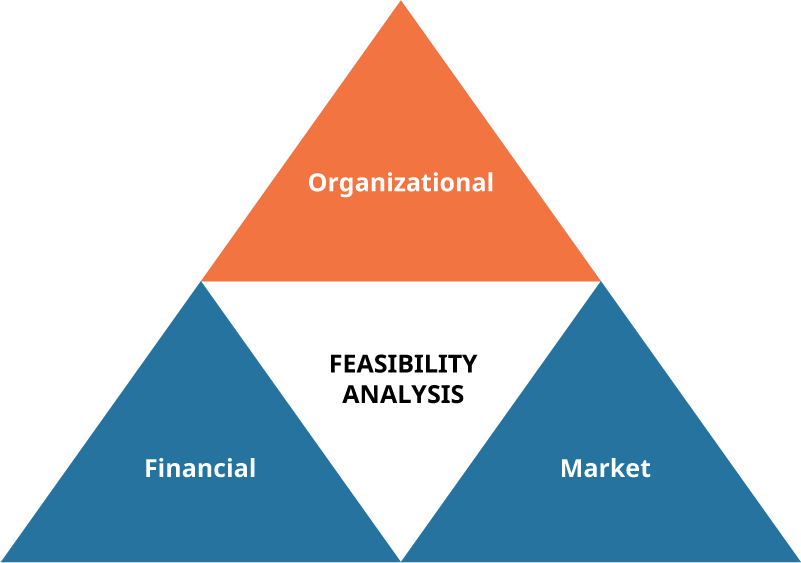
Resource sufficiency pertains to nonfinancial resources that the venture will need to move forward successfully and aims to assess whether an entrepreneur has a sufficient amount of such resources. The organization should critically rank its abilities in six to twelve types of such critical nonfinancial resources, such as availability of office space, quality of the labor pool, possibility of obtaining intellectual property protections (if applicable), willingness of high-quality employees to join the company, and likelihood of forming favorable strategic partnerships. If the analysis reveals that critical resources are lacking, the venture may not be possible as currently planned.
Financial Feasibility Analysis
A financial analysis seeks to project revenue and expenses (forecasts come later in the full business plan); project a financial narrative; and estimate project costs, valuations, and cash flow projections Figure 5.1.4.2.
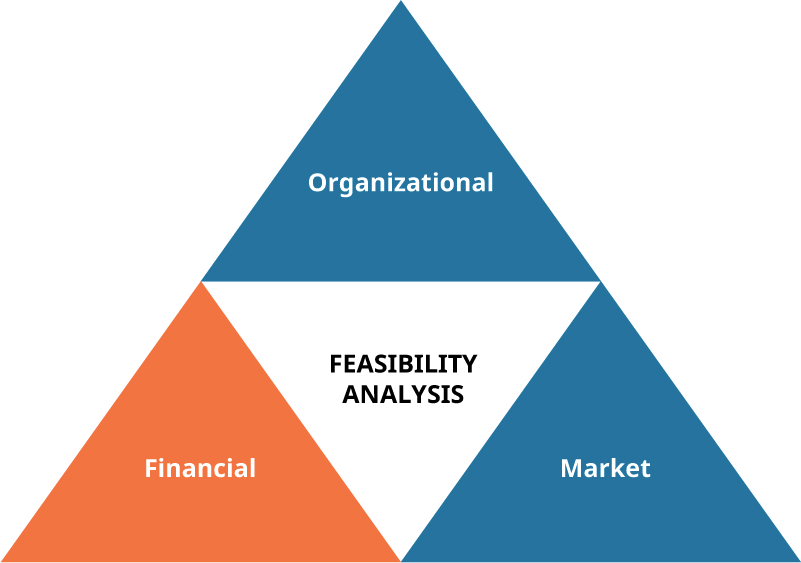
The financial analysis may typically include these items:
- A twelve-month profit and loss projection
- A three- or four-year profit-and-loss projection
- A cash-flow projection
- A projected balance sheet
- A breakeven calculation
The financial analysis should estimate the sales or revenue that you expect the business to generate. A number of different formulas and methods are available for calculating sales estimates. You can use industry or association data to estimate the sales of your potential new business. You can search for similar businesses in similar locations to gauge how your business might perform compared with similar performances by competitors. One commonly used equation for a sales model multiplies the number of target customers by the average revenue per customer to establish a sales projection:
T × A = ST × A = S
Target(ed) Customers/Users × Average Revenue per Customer = Sales Projection
Another critical part of planning for new business owners is to understand the breakeven point , which is the level of operations that results in exactly enough revenue to cover costs. It yields neither a profit nor a loss. To calculate the breakeven point, you must first understand the two types of costs: fixed and variable. Fixed costs are expenses that do not vary based on the amount of sales. Rent is one example, but most of a business’s other costs operate in this manner as well. While some costs vary from month to month, costs are described as variable only if they will increase if the company sells even one more item. Costs such as insurance, wages, and office supplies are typically considered fixed costs. Variable costs fluctuate with the level of sales revenue and include items such as raw materials, purchases to be sold, and direct labor. With this information, you can calculate your breakeven point—the sales level at which your business has neither a profit nor a loss. Projections should be more than just numbers: include an explanation of the underlying assumptions used to estimate the venture’s income and expenses.
Projected cash flow outlines preliminary expenses, operating expenses, and reserves—in essence, how much you need before starting your company. You want to determine when you expect to receive cash and when you have to write a check for expenses. Your cash flow is designed to show if your working capital is adequate. A balance sheet shows assets and liabilities, necessary for reporting and financial management. When liabilities are subtracted from assets, the remainder is owners’ equity.
Market Feasibility Analysis
A market analysis enables you to define competitors and quantify target customers and/or users in the market within your chosen industry by analyzing the overall interest in the product or service within the industry by its target market Figure 5.1.4.3. You can define a market in terms of size, structure, growth prospects, trends, and sales potential. This information allows you to better position your company in competing for market share. After you’ve determined the overall size of the market, you can define your target market, which leads to a total available market (TAM) , that is, the number of potential users within your business’s sphere of influence. This market can be segmented by geography, customer attributes, or product-oriented segments. From the TAM, you can further distill the portion of that target market that will be attracted to your business. This market segment is known as a serviceable available market (SAM) .
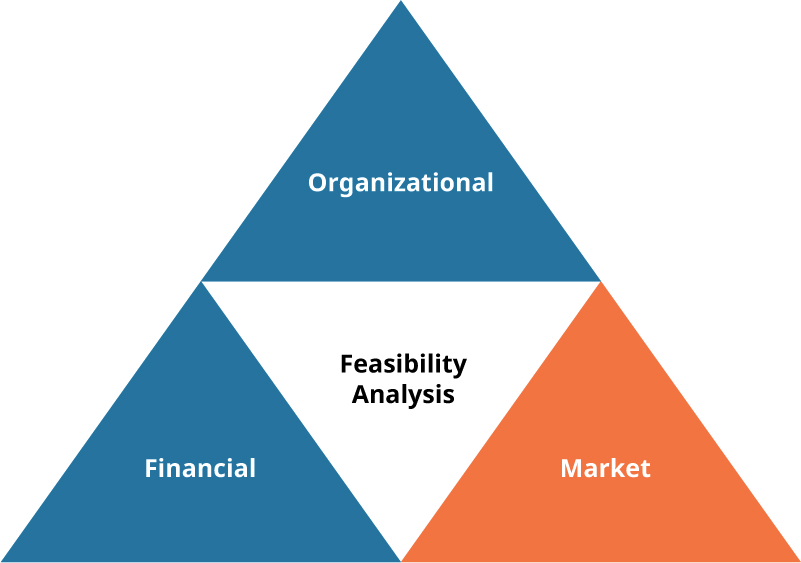
Projecting market share can be a subjective estimate, based not only on an analysis of the market but also on pricing, promotional, and distribution strategies. As is the case for revenue, you will have a number of different forecasts and tools available at your disposal. Other items you may include in a market analysis are a complete competitive review, historical market performance, changes to supply and demand, and projected growth in demand over time.
ARE YOU READY?
You’ve been hired by a leading hotel chain to determine the market and financial potential for the development of a mixed-use property that will include a full-service hotel in downtown Orlando, located at 425 East Central Boulevard, in Orlando, Florida. The specific address is important so you can pinpoint existing competitors and overall suitability of the site. Using the information given, conduct a market analysis that can be part of a larger feasibility study.
WORK IT OUT
Location Feasibility

You’re considering opening a boutique clothing store in downtown Atlanta. You’ve read news reports about how downtown Atlanta and the city itself are growing and undergoing changes from previous decades. With new development taking place there, you’re not sure whether such a venture is viable. Outline what steps you would need to take to conduct a feasibility study to determine whether downtown Atlanta is the right location for your planned clothing store.
Applying Feasibility Outcomes
After conducting a feasibility analysis, you must determine whether to proceed with the venture. One technique that is commonly used in project management is known as a go-or-no-go decision . This tool allows a team to decide if criteria have been met to move forward on a project. Criteria on which to base a decision are established and tracked over time. You can develop criteria for each section of the feasibility analysis to determine whether to proceed and evaluate those criteria as either “go” or “no go,” using that assessment to make a final determination of the overall concept feasibility. Determine whether you are comfortable proceeding with the present management team, whether you can “go” forward with existing nonfinancial resources, whether the projected financial outlook is worth proceeding, and make a determination on the market and industry. If satisfied that enough “go” criteria are met, you would likely then proceed to developing your strategy in the form of a business plan.
WHAT CAN YOU DO?
Love Beyond Walls
When Terence Lester saw a homeless man living behind an abandoned, dilapidated building, he asked the man if he could take him to a shelter. The man scoffed, replying that Lester should sleep in a shelter. So he did—and he saw the problem through the homeless man’s perspective. The shelter was crowded and smelly. You couldn’t get much sleep, because others would try to steal your meager belongings. The dilapidated building provided isolation away from others, but quiet and security in its own way that the shelter could not. This experience led Lester to voluntarily live as a homeless person for a few weeks. His journey led him to create Love Beyond Walls (www.lovebeyondwalls.org), an organization that aids the homeless, among other causes. Lester didn’t conduct a formal feasibility study, but he did so informally by walking in his intended customers’ shoes—literally. A feasibility study of homelessness in a particular area could yield surprising findings that might lead to social entrepreneurial pursuits.
- What is a social cause you think could benefit from a formal feasibility study around a potential entrepreneurial solution?

- Research Guides
ENTR 2P91: Entrepreneurship
Sample feasibility reports.
- Idea Generation
- Product / Service Analysis
- NAICS Code Help
- Organizational Feasibility
- Financial Feasibility
- Find Academic Research

Sample academic feasibility reports can be found by searching Google Scholar using the keywords business feasibility report or business feasibility study. For example:
- The UBC public bicycle system feasibility study (Adam Cooper, UBC School of Community and Regional Planning)
- Feasibility study for renovating an old barn into a tasting room for K-Dot winery (Kendall Ott, California Polytechnic State University)
- Feasibility study for a brewpub (John Gallante and Daniel Price, California Polytechnic State University)
- A Feasibility study for establishing a sustainability consulting firm (Susan F. Mathieu, Simon Fraser University)
The following resources provide additional guidance on conducting your feasibility analysis and writing it up:
- Feasibility Study Outline (Iowa State University Extension & Outreach) An example outline of a feasibility report including detailed information about what should be included in each section of the report.
- Feasibility Analysis for the New Venture Nonprofit Enterprise (journal article) This article in the New England Journal of Entrepreneurship explores the value of feasibility analysis for the pre-launch nonprofit enterprise. Note: Access restricted to authorized Brock University users.
- Full Feasibility Analysis (Pearson Education) (PDF) Tools and templates for conducting a full feasibility analysis including: product/service, industry/market, organizational, financial and an overallassessment. Originally published as Appendix 3.1 of the textbook "Entrepreneurship: successfully launching new ventures" by Bruce Barringer and Duane Ireland.
- Evaluating the feasibility of business opportunities (OMAFRA Factsheet) A "How to" Factsheet Prepared by the Ontario Ministry of Agriculture, Food and Rural Affairs (2017)
Business Plans - Samples
The following sources contain sample business plans for different types of small businesses:
- Business Plans Handbook Series (Gale Ebooks Database) This source is a compilation of actual business plans developed by small businesses throughout North America. The Library has online access to the most recent volumes (v.50, 2021 - v.11, 2006) via the Gale eBooks database. The most recent volume has a cumulative index of all plans by plan type. You may also search within the full text of all online business plans in this series.
- Bplans.com - sample plans Contains over 300 different sample plans, organized by category (restaturant, cafe & bakery; retail & online stores; service; medical & health care).
- Writing a Business Plan: An Example for a Small Premium Winery (Cornell University) (PDF) A detailed example business plan, with good examples of how to incorporate in-text citations in the industry and competitor analysis sections, and a reference list. more info... close... An Extension Bulletin prepared by Mark E. Pisoni and Gerald B. White, Charles H. Dyson School of Applied Economics and Management at Cornell University.
- Business Plan for Caregaroo (Kiana Mohseni, Simon Fraser University) MBA student project (Simon Fraser University)
Business Plans - Writing
The following sources provide guidance on writing business plans and may also include a sample plan or template.
- Writing your business plan (Canada Business Network) This Government of Canada site provides extensive guidance for entrepreneurs on business planning and writing your business plan.
- Essential Elements of a good business plan (US Small Business Administration)
- Planning for success: your guide to preparing a business & marketing plan (PDF file) This guide from the Atlantic Canada Opportunities Agency walks entrepreneurs through the process of preparing a business & marketing plan. It includes recommendations on what to include in each section and how to calculate and display relevant data such as market share, breakeven analysis, cash flow forecasts and financial statements.
- << Previous: Financial Feasibility
- Next: Find Academic Research >>
- Last Updated: Apr 17, 2024 8:35 AM
- URL: https://researchguides.library.brocku.ca/ENTR2P91

Financial Assumptions and Your Business Plan
Written by Dave Lavinsky

Financial assumptions are an integral part of a well-written business plan. You can’t accurately forecast the future without them. Invest the time to write solid assumptions so you have a good foundation for your financial forecast.
Download our Ultimate Business Plan Template here
What are Financial Assumptions?
Financial assumptions are the guidelines you give your business plan to follow. They can range from financial forecasts about costs, revenue, return on investment, and operating and startup expenses. Basically, financial assumptions serve as a forecast of what your business will do in the future. You need to include them so that anyone reading your plan will have some idea of how accurate its projections may be.
Of course, your financial assumptions should accurately reflect the information you’ve given in your business plan and they should be reasonably accurate. You need to keep this in mind when you make them because if you make outlandish claims, it will make people less likely to believe any part of your business plan including other financial projections that may be accurate.
That’s why you always want to err on the side of caution when it comes to financial assumptions for your business plan. The more conservative your assumptions are the more likely you’ll be able to hit them, and the less likely you’ll be off by so much that people will ignore everything in your plan.
Why are Financial Assumptions Important?
Many investors skip straight to the financial section of your business plan. It is critical that your assumptions and projections in this section be realistic. Plans that show penetration, operating margin, and revenues per employee figures that are poorly reasoned; internally inconsistent, or simply unrealistic greatly damage the credibility of the entire business plan. In contrast, sober, well-reasoned financial assumptions and projections communicate operational maturity and credibility.
For instance, if the company is categorized as a networking infrastructure firm, and the business plan projects 80% operating margins, investors will raise a red flag. This is because investors can readily access the operating margins of publicly-traded networking infrastructure firms and find that none have operating margins this high.
As much as possible, the financial assumptions should be based on actual results from your or other firms. As the example above indicates, it is fairly easy to look at a public company’s operating margins and use these margins to approximate your own. Likewise, the business plan should base revenue growth on other firms.
Many firms find this impossible, since they believe they have a breakthrough product in their market, and no other company compares. In such a case, base revenue growth on companies in other industries that have had breakthrough products. If you expect to grow even faster than they did (maybe because of new technologies that those firms weren’t able to employ), you can include more aggressive assumptions in your business plan as long as you explain them in the text.
The financial assumptions can either enhance or significantly harm your business plan’s chances of assisting you in the capital-raising process. By doing the research to develop realistic assumptions, based on actual results of your or other companies, the financials can bolster your firm’s chances of winning investors. As importantly, the more realistic financials will also provide a better roadmap for your company’s success.
Finish Your Business Plan Today!
Financial assumptions vs projections.
Financial Assumptions – Estimates of future financial results that are based on historical data, an understanding of the business, and a company’s operational strategy.
Financial Projections – Estimates of future financial results that are calculated from the assumptions factored into the financial model.
The assumptions are your best guesses of what the future holds; the financial projections are numerical versions of those assumptions.
Key Assumptions By Financial Statement
Below you will find a list of the key business assumptions by the financial statement:
Income Statement
The income statement assumptions should include revenue, cost of goods sold, operating expenses, and depreciation/amortization, as well as any other line items that will impact the income statement.
When you are projecting future operating expenses, you should project these figures based on historical information and then adjust them as necessary with the intent to optimize and/or minimize them.
Balance Sheet
The balance sheet assumptions should include assets, liabilities, and owner’s equity, as well as any other line items that will impact the balance sheet. One of the most common mistakes is not including all cash inflows and outflows.
Cash Flow Statement
Cash flow assumptions should be made, but they do not impact the balance sheet or income statement until actually received or paid. You can include the cumulative cash flow assumption on the financial model to be sure it is included with each year’s projections.
The cumulative cash flow assumption is useful for showing your investors and potential investors how you will spend the money raised. This line item indicates how much of the initial investment will be spent each year, which allows you to control your spending over time.
Notes to Financial Statements
The notes to financial statements should explain assumptions made by management regarding accounting policies, carrying value of long-lived assets, goodwill impairment testing, contingencies, and income taxes. It is important not only to list these items within the notes but also to provide a brief explanation.
What are the Assumptions Needed in Preparing a Financial Model?
In our article on “ How to Create Financial Projections for Your Business Plan ,” we list the 25+ most common assumptions to include in your financial model. Below are a few of them:
For EACH key product or service you offer:
- What is the number of units you expect to sell each month?
- What is your expected monthly sales growth rate?
For EACH subscription/membership you offer:
- What is the monthly/quarterly/annual price of your membership?
- How many members do you have now or how many members do you expect to gain in the first month/quarter/year?
Cost Assumptions
- What is your monthly salary? What is the annual growth rate in your salary?
- What is your monthly salary for the rest of your team? What is the expected annual growth rate in your team’s salaries?
- What is your initial monthly marketing expense? What is the expected annual growth rate in your marketing expense?
Assumptions related to Capital Expenditures, Funding, Tax and Balance Sheet Items
- How much money do you need for capital expenditures in your first year (to buy computers, desks, equipment, space build-out, etc.)
- How much other funding do you need right now?
- What is the number of years in which your debt (loan) must be paid back
Properly Preparing Your Financial Assumptions
So how do you prepare your financial assumptions? It’s recommended that you use a spreadsheet program like Microsoft Excel. You’ll need to create separate columns for each line item and then fill in the cells with the example information described below.
Part 1 – Current Financials
Year to date (YTD) units sold and units forecast for next year. This is the same as YTD revenue, but you divide by the number of days in the period to get an average daily amount. If your plan includes a pro forma financial section, your financial assumptions will be projections that are consistent with the pro forma numbers.
Part 2 – Financial Assumptions
Estimated sales forecasts for next year by product or service line, along with the associated margin. List all major items in this section, not just products. For instance, you might include “Professional Services” as a separate item, with revenue and margin information.
List the number of employees needed to support this level of business, including yourself or key managers, along with your cost assumptions for compensation, equipment leasing (if applicable), professional services (accounting/legal/consultants), and other line items.
Part 3 – Projected Cash Flow Statement and Balance Sheet
List all key assumptions like: sources and uses of cash, capital expenditures, Planned and Unplanned D&A (depreciation & amortization), changes in operating assets and liabilities, along with those for investing activities. For example, you might list the assumptions as follows:
- Increases in accounts receivable from customers based on assumed sales levels
- Decreases in inventory due to increased sales
- Increases in accounts payable due to higher expenses for the year
- Decrease in unearned revenue as evidenced by billings received compared with those projected (if there is no change, enter 0)
- Increase/decrease in other current assets due to changes in business conditions
- Increase/decrease in other current liabilities due to changes in business conditions
- Increases in long term debt (if necessary)
- Cash acquired from financing activities (interest expense, dividends paid, etc.)
You make many of these assumptions based on your own experience. It is also helpful to look at the numbers for public companies and use those as a benchmark.
Part 4 – Future Financials
This section is for more aggressive financial projections that can be part of your plan, but which you cannot necessarily prove at the present time. This could include:
- A projection of earnings per share (EPS) using the assumptions above and additional information such as new products, new customer acquisition, expansion into new markets
- New product lines or services to be added in the second year. List the projected amount of revenue and margin associated with these items
- A change in your gross margins due to a specific initiative you are planning, such as moving from a high volume/low margin business to a low volume/high margin business
Part 5 – Calculations
Calculate all critical financial numbers like:
- Cash flow from operating activities (CFO)
- Operating income or loss (EBITDA) (earnings before interest, taxes, depreciation, and amortization)
- EBITDA margin (gross profits divided by revenue less cost of goods sold)
- Adjusted EBITDA (CFO plus other cash changes like capital expenditure, deferred taxes, non-cash stock compensation, and other items)
- Net income or loss before tax (EBT)
- Cash from financing activities (increase/decrease in debt and equity)
Part 6 – Sensitivity Analysis
If your assumptions are reasonably accurate, you will have a column for “base case” and a column for “worst case.” If you have a lot of variables with different possible outcomes, just list the potential range in one cell.
Calculate both EBITDA margins and EPS ranges at each level.
Part 7 – Section Highlights
Just list the two or three key points you want to make. If it is hard to distill them down, you need to go back and work on Part 3 until it makes sense.
Part 8 – Financial Summary
Include all the key numbers from your assumptions, section highlights, and calculations. In one place, you can add up CFO, EPS at different levels, and EBITDA margins under both base case and worst-case scenarios to give a complete range for each assumption.
The key to a successful business plan is being able to clearly communicate your financial assumptions. Be sure to include your assumptions in the narrative of your plan so you can clearly explain why you are making them. If you are using the business plan for financing or other purposes, it may also be helpful to include a separate “financials” section so people unfamiliar with your industry can quickly find and understand key information.
How to Finish Your Business Plan in 1 Day!
Don’t you wish there was a faster, easier way to finish your business plan and financial projections?
With Growthink’s Ultimate Business Plan Template you can finish your plan in just 8 hours or less!
It includes a full financial model. It lists all the key financial assumptions and you simply need to plug in answers to the assumptions and your complete financial projections (income statement, balance sheet, cash flow statement, charts and graphs) are automatically generated!
Click here to see how Growthink’s professional business plan consulting services can create your business plan for you.
OR, Let Us Develop Your Plan For You
Since 1999, Growthink has developed business plans for thousands of companies who have gone on to achieve tremendous success.
Click here to see how our professional business plan writers can create your business plan for you.
If you just need a financial model for your business plan, learn more about our financial modeling services .
Other Resources for Writing Your Business Plan
- How to Write an Executive Summary
- How to Expertly Write the Company Description in Your Business Plan
- How to Write the Market Analysis Section of a Business Plan
- The Customer Analysis Section of Your Business Plan
- Completing the Competitive Analysis Section of Your Business Plan
- How to Write the Management Team Section of a Business Plan + Examples
- How to Create Financial Projections for Your Business Plan
- Everything You Need to Know about the Business Plan Appendix
- Business Plan Conclusion: Summary & Recap
Other Helpful Business Plan Articles & Templates


Free Project Management Templates
Feasibility Study Template
A good Feasibility Study helps to objectively decide whether to proceed with a proposed project. A Feasibility Study should have broad considerations when considering whether to undertake a new project. It should consider things such as technological limitations, the marketplace, your marketing strategy, staffing requirements, schedule and financial projections. Our free Feasibility Study template helps you to get started quickly with your own feasibility study.
Download Template
1. executive summary.
The executive summary provides an overview of the content contained in the feasibility study document. Many people write this section after the rest of the document is completed. This section is important in that it provides a higher level summary of the detail contained within the rest of the document. Remember to remove the green instructional portion of the Feasibility Study Template before making your document final.
Alan’s Best Chocolates (ABC) is a leader in the sales of chocolates and confections throughout the United States. ABC’s products are sold from 50 stores throughout the country and maintain a reputation for superior taste and quality. While ABC’s sales have grown over the past 10 years, the rate of growth has slowed significantly. One key factor for this slowing growth rate is the shift in the marketplace to purchasing chocolates and confections online. While ABC maintains a web site, it is not capable of hosting an e-commerce platform for online sales. ABC’s sales occur only in its brick and mortar facilities and the company is losing potential customers to competitors who provide online sales. The chocolate and confections marketplace is healthy and shows a continued growth trajectory over the next five to ten years. ABC is in a position to capitalize on this online marketplace by leveraging existing technologies, industry best practices, and an aggressive marketing and sales campaign to ramp up the company’s growth projections for the foreseeable future.
2. Description of Products and Services
This section of the feasibility study provides a high level description of the products and/or services which are being considered as past of the feasibility study. The purpose of this section is to provide detailed descriptions of exactly what the organization is considering so this information can be applied to the following sections of the document. It is important that this description captures the most important aspects of the products and/or services that the organization is considering as well as how it may benefit customers and the organization.
ABC is considering a move to create and provide an online platform from which to sell its existing product line. Until now ABC has only sold its products from its chain of brick and mortar facilities and has been limited to sales within the geographical regions where its stores reside. By doing so, ABC has not been able to capitalize on the growing trend of online sales within the chocolate and confections marketplace. By offering its products through an online platform, ABC can market its products to an entirely new market, increase revenue and growth projections, and allow customers to purchase our products from the convenience of their own homes.
There are no proposed changes to ABC’s current product offerings as a result of this study. Online sales will include only current products and any changes to this product line must be considered outside of the purpose of this document.
3. Technology Considerations
This section of the feasibility study should explain any considerations the organization must make with regards to technology. Many new initiatives rely on technology to manage or monitor various business functions. New technology may be developed internally or contracted through a service provider and always result in costs which must be weighed in determining the path forward.
Upgraded technological capability will be required for ABC to move toward offering an online marketplace from which customers may purchase our products. Customers demand a simple and easy way by which to conduct online transactions and it is imperative that all transactions are conducted in a secure manner. While ABC maintains a web site with product lists and descriptions, it does not currently allow for purchasing to be done online. This functionality must be integrated with our current web site to allow for secure purchases to be made. Additionally, new online marketing functionality must be considered in order to target existing and potential customers through methods such as e-mailing lists, promotional advertisements, and loyalty discounts.
While ABC maintains a small information technology (IT) group, the expertise does not currently exist internally to design, build, and implement the sort of extensive online platform required for this effort. Therefore, the recommendation is to contract this work out to an internet marketplace provider who can work with ABC to meet its needs within the determined timeframe and budget. It should be noted that while ABC does not have this expertise internally, the technology exists and is in use throughout the marketplace which lowers the risk of this concept considerably.
ABC currently maintains a high speed internet connection, web server, and the latest software. With the addition of an e-commerce portal it is expected that there will be an overall cost increase of 5-10% for web server operations and maintenance costs.
4. Product/Service Marketplace
This part of the feasibility study describes the existing marketplace for the products and/or services the organization is considering. It may describe who the target market consists of for these products or services, who the competitors are, how products will be distributed, and why customers might choose to buy our products/services. Most marketplaces are dynamic environments in which things change constantly. To enter a new marketplace blindly will usually result in an organization not fully understanding its role and not maximizing its resulting benefits.
The online marketplace for chocolates and confections has been thriving for many years. In FY20xx online chocolate sales accounted for approximately $20 million or 20% of total chocolate sales worldwide. While chocolates and confections are available in almost every store, our primary marketplace consists of specialty chocolates and confections. All of ABC’s current major competitors already have an established online presence of at least 3-5 years. The top 3 competitors are currently: Smith’s Chocolates, Worldwide Candy, and Chocolate International. A large majority of ABC’s customer base are returning customers and referrals from existing customers. By providing a more convenient means of purchasing our products online it is expected that we will retain these customers while conducting an online marketing campaign for new customers as well.
ABC will distribute online purchases via direct shipping from the nearest store location. This will allow ABC to provide timely shipping and eliminate the need for a central warehouse or facility from which to store and ship its products. Such a facility would require a significant capital investment as well as increased operation and maintenance costs. However, based on anticipated growth projections, ABC must ensure that all store locations maintain adequate inventories on hand to satisfy customer demand.
5. Marketing Strategy
Here the feasibility study provides a high level description of how the organization will market its product or service. Some topics which should be included are: how does an organization differentiate itself from its competitors; types of marketing the organization will utilize; and who the organization will target. Marketing efforts must be focused on the right target groups in order to yield the greatest return on investment.
In order to be successful, ABC must differentiate itself from competitors in order to appeal to customers in the online marketplace. To do this, ABC will utilize its practice of personalizing its product packaging which it currently offers in-store customers. Current competitors do not currently provide any personalization of packaging. Customers will have the ability to personalize messages on or inside of product packaging, request specific color-based themes, or tailor packaging for special occasions or events.
ABC will implement a customer e mailing list in order to send product promotions, sales advertisements, and other special offerings to customers who register. Additionally, ABC will offer referral incentives to customers who refer our products to friends and family in order to provide additional incentives. ABC will also maintain a customer database in order to determine its target customer groups and geographical regions. ABC will research marketing intelligence providers to determine the benefits and costs of purchasing customer information for bulk email campaigns as well. Another important consideration of ABC’s online marketing strategy is cost. Electronic marketing communication costs are very small in comparison to direct mail marketing which ABC currently utilizes. However, we expect the additional revenue from online sales to greatly outweigh these additional electronic marketing costs.
It is important to note that ABC’s current marketing and sales staff will require training in online marketing and sales practices. This training will need to be contracted to a training provider as part of our startup costs and schedule.
6. Organization and Staffing
With many new products or services there may be a need for additional staffing or for an organization to restructure in order to accommodate the change. These are important considerations as they may result in increased costs or require an organization to change its practices and processes.
The ABC online sales campaign is not anticipated to significantly affect the organizational structure of the company. There are, however, several staffing additions required to successfully implement the online sales campaign. All of these positions will work within existing departments and report to department managers.
Staffing Position #1: Online Sales Manager – this full time position will lead sales staff in identifying sales opportunities and converting these opportunities to actual sales. This person will report to ABC’s Director of Sales and will work in ABC headquarters.
Staffing Position #2: Online Marketing Manager – this full time position will lead marketing staff in identifying target customer groups/markets and conducting online advertising/marketing efforts to maximize traffic to ABCs online marketplace. This person will report to ABC’s Director of Marketing and will work in ABC headquarters.
7. Schedule
This section of the feasibility study is intended to provide a high level framework for implementation of the product or service being considered. This section is not intended to include a detailed schedule as this would be developed during project planning should this initiative be approved. This section may include some targeted milestones and timeframes for completion as a guideline only.
The ABC online sales campaign is expected to take six months from project approval to launch of the e-commerce platform. Many of the foundations for this platform, such as high-speed internet and web server capability, are already available. The following is a high level schedule of some significant milestones for this initiative:
Jan 1, 20xx: Initiate Project February 1, 20xx: Project kickoff meeting March 1, 20xx: Complete online sales site design April 1, 20xx: Complete testing of online sales site June 1, 20xx: Complete beta testing trials of online sales site July 2, 20xx: Go live with site launch
Upon approval of this project a detailed schedule will be created by the assigned project team to include all tasks and deliverables.
8. Financial Projections
The financial projections for the feasibility study provides a description of the financial projections the new initiative is expected to yield versus additional costs. Financial projections are one key aspect of new project selection criteria. There are many ways to present these projections. Net present value (NPV), cost-benefit calculations, and balance sheets are just some examples of how financial projections may be illustrated. This section should also provide the assumptions on which the illustrated financial projections are based.
The financial projections for the addition of an online sales platform for ABC are highlighted in the table below. These figures account for projected online sales, additional staffing requirements, shipping, material, and insurance costs, contract support for IT and training needs, and web server and hosting costs.
The assumptions for these projections are as follows:
- In store sales projections remain unchanged
- All milestones are performed in accordance with the schedule
- All transactions are closed yearly with no carry-over to subsequent years
9. Findings and Recommendations
This section of the feasibility study template provides an area where to summarize the findings of the feasibility study and explain why this course of action is or is not recommended. This section may include a description of pros and cons for the initiative being considered. This section should be brief since most of the detail is included elsewhere in the document. Additionally, it should capture the likelihood of success for the business idea being studied.
Based on the information presented in this feasibility study, it is recommended that ABC approves the online sales initiative and begins project initiation. The findings of this feasibility study show that this initiative will be highly beneficial to the organization and has a high probability of success. Key findings are as follows:
Technology:
- Will utilize existing technology which lowers project risk
- E commerce infrastructure will be contracted out to vendor which allows ABC to share risk
- Once in place this technology is simple to operate and maintain for a relatively low cost
- This initiative will allow ABC to reach large number of target groups electronically at a low cost
- ABC can expand customer base beyond geographic areas where stores are currently located
- The marketplace for online chocolate and confection sales is in a steady state of growth
- ABC is able to differentiate itself from its competitors and will utilize incentive programs to target new consumers
Organizational:
- Minimal increases to staffing are required with no changes to organizational structure
- No new facilities or capital investments are required
- Break even point occurs early in the second year of operation
- Five year projections show online sales accounting for 25% of total sales
- ABC will be in position to capture greater market share by maintaining both an in-store and online presence
Be sure to download our free project plan template . All successful projects start with a well prepared project plan.

500+ business plans and financial models
Furniture Store Business Plan PDF Example
- May 7, 2024
- Business Plan

Creating a comprehensive business plan is crucial for launching and running a successful furniture store. This plan serves as your roadmap, detailing your vision, operational strategies, and financial plan. It helps establish your furniture store’s identity, navigate the competitive market, and secure funding for growth.
This article not only breaks down the critical components of a furniture store business plan, but also provides an example of a business plan to help you craft your own.
Whether you’re an experienced entrepreneur or new to the retail industry, this guide, complete with a business plan example, lays the groundwork for turning your furniture store concept into reality. Let’s dive in!
Our furniture store business plan is structured to cover all essential aspects needed for a comprehensive strategy. It outlines the shop’s operations, marketing strategy , market environment, competitors, management team, and financial forecasts.
- Executive Summary : Offers an overview of your furniture shop’s business concept, market analysis , management, and financial strategy.
- Store & Location: Describes the shop’s design, layout, and why its location is appealing to potential customers.
- Products & Pricing: Lists the types of furniture offered by your shop, including pricing structure.
- Key Stats: Shares industry size , growth trends, and relevant statistics for the furniture market.
- Key Trends: Highlights recent trends affecting the furniture sector.
- Key Competitors : Analyzes main competitors in the area and how your shop differs from them.
- SWOT : Strengths, weaknesses, opportunities, and threats analysis.
- Marketing Plan : Strategies for attracting and retaining customers.
- Timeline : Key milestones and objectives from start-up through the first year of operation.
- Management: Information on who manages the furniture shop and their roles.
- Financial Plan: Projects the shop’s 5-year financial performance, including revenue, profits, and expected expenses.

Furniture Store Business Plan

Fully editable 30+ slides Powerpoint presentation business plan template.
Download an expert-built 30+ slides Powerpoint business plan template
Executive Summary
The Executive Summary introduces your furniture store’s business plan, offering a concise overview of your store and its products. It should detail your market positioning, the range of furniture and home decor items you offer, its location, size, and an outline of day-to-day operations.
This section should also explore how your furniture store will integrate into the local market, including the number of direct competitors within the area, identifying who they are, along with your store’s unique selling points that differentiate it from these competitors.
Furthermore, you should include information about the management and co-founding team, detailing their roles and contributions to the store’s success. Additionally, a summary of your financial projections, including revenue and profits over the next five years, should be presented here to provide a clear picture of your furniture store’s financial plan.
Make sure to cover here _ Business Overview _ Market Overview _ Management Team _ Financial Plan

Dive deeper into Executive Summary
Business Overview
Store & location.
Briefly describe the furniture store’s physical environment, emphasizing its design, layout, and the welcoming atmosphere it offers to customers. Mention the store’s location, highlighting its accessibility and the convenience it offers to shoppers, such as proximity to popular shopping districts or ease of parking. Explain why this location is advantageous in attracting your target clientele.
Supply & Products
Detail the range of furniture and related products offered, from basic home furnishings to specialized items like custom-made pieces, home accessories, or eco-friendly furniture. Outline your pricing strategy , ensuring it reflects the quality of products provided and matches the market you’re targeting. Highlight any promotions, financing options, or loyalty programs that provide added value to your customers, encouraging repeat business and customer loyalty.
Make sure to cover here _ Store & Location _ Supply & Products

Market Overview
Industry size & growth.
In the Market Overview of your furniture store business plan, start by examining the size of the furniture retail industry and its growth potential. This analysis is crucial for understanding the market’s scope and identifying expansion opportunities.
Key Market Trends
Proceed to discuss recent market trends , such as the increasing consumer interest in personalized furniture solutions, sustainable and eco-friendly products, and innovative design styles. For example, highlight the demand for furniture that caters to specific lifestyle needs and preferences, alongside the rising popularity of environmentally conscious furniture stores.
Key Competitors
Then, consider the competitive landscape, which includes a range of furniture stores from high-end boutiques to budget-friendly options, as well as online furniture sales trends. For example, emphasize what makes your store distinctive, whether it’s through exceptional customer service, a unique range of products, or specialization in certain types of furniture. This section will help articulate the demand for furniture store services, the competitive environment, and how your store is positioned to thrive within this dynamic market.
Make sure to cover here _ Industry size & growth _ Key competitors _ Key market trends

Dive deeper into Key competitors
First, conduct a SWOT analysis for the furniture store , highlighting Strengths (such as quality craftsmanship and a diverse product range), Weaknesses (including high operational costs or intense competition), Opportunities (for example, an increasing trend in home improvement and interior design), and Threats (such as economic downturns that may decrease consumer spending on non-essential items).
Marketing Plan
Next, develop a marketing strategy that outlines how to attract and retain customers through targeted advertising, promotional discounts, engaging social media presence, and community involvement. This could include collaborations with interior designers, staging partnerships with real estate companies, or hosting DIY furniture workshops to increase brand visibility and consumer engagement.
Finally, create a detailed timeline that outlines critical milestones for the furniture store’s opening, marketing efforts, customer base growth, and expansion objectives, ensuring the business moves forward with clear direction and purpose. This timeline should include key dates for product launches, seasonal sales campaigns, and potential entry into new markets or online expansion.
Make sure to cover here _ SWOT _ Marketing Plan _ Timeline

Dive deeper into SWOT
Dive deeper into Marketing Plan
The Management section focuses on the furniture store’s management and their direct roles in daily operations and strategic direction. This part is crucial for understanding who is responsible for making key decisions and driving the furniture store toward its financial and operational goals.
For your furniture store business plan, list the core team members, their specific responsibilities, and how their expertise supports the business.

Financial Plan
The Financial Plan section is a comprehensive analysis of your financial projections for revenue, expenses, and profitability. It lays out your furniture store’s approach to securing funding, managing cash flow, and achieving breakeven.
This section typically includes detailed forecasts for the first 5 years of operation, highlighting expected revenue, operating costs and capital expenditures.
For your furniture store business plan, provide a snapshot of your financial statement (profit and loss, balance sheet, cash flow statement), as well as your key assumptions (e.g. number of customers and prices, expenses, etc.).
Make sure to cover here _ Profit and Loss _ Cash Flow Statement _ Balance Sheet _ Use of Funds

Privacy Overview

IMAGES
VIDEO
COMMENTS
A financial feasibility study provides a detailed financial plan and budget for a proposed project, investment or venture, which can be used as a roadmap to guide its development and implementation, ensuring that resources are allocated effectively and efficiently, leading to the success of the project. 4. Unlocking new opportunities.
What are the similarities between a Business Plan and a Financial Feasibility Study? Often, a financial feasibility analysis can serve as the financial plan within a business plan in its short form. The financial plan should answer the same or similar questions to be answered by a financial feasibility study. ... Below is an example of a simple ...
Financial feasibility analysis is a systematic process that helps evaluate the viability, profitability, and sustainability of a project, business idea, or investment opportunity. This comprehensive guide aims to provide a practical overview of financial feasibility analysis, its key components, and its significance in making informed business ...
A financial feasibility study should be conducted at the onset to determine the economic viability of a proposed venture before proceeding to the preparation of a business plan. It identifies the startup costs, makes projections of profits and cash flows and determines the return of the investment.
A feasibility study is a systematic and comprehensive analysis of a proposed project or business idea to assess its viability and potential for success. It involves evaluating various aspects such as market demand, technical feasibility, financial viability, and operational capabilities.
Financial Feasibility Analysis. A financial analysis seeks to project revenue and expenses (forecasts come later in the full business plan); project a financial narrative; and estimate project costs, valuations, and cash flow projections Figure 11.13. Figure 11.3.2 11.3. 2: An analysis of financial feasibility focuses on expenses, cash flow ...
For a general set of guidelines to help you get started, here are some basic steps to conduct and report a feasibility study for major product opportunities or features. 1. Clearly define the opportunity. Imagine your user base is facing a significant problem that your product doesn't solve. This is an opportunity.
A feasibility study, as the name suggests, is designed to reveal whether a project/plan is feasible. It is an assessment of the practicality of a proposed project/plan. A feasibility study is part of the initial design stage of any project/plan. It is conducted in order to objectively uncover the strengths and weaknesses of a proposed project ...
4. Financial Projections. Every good business endeavor is meant to make a profit. Your feasibility study should determine if the project or plan is a financially wise investment. The financial projections section of the feasibility template outlines and discusses critical financial metrics. Considering including and discussing: Capital needs.
This financial plan projections template comes as a set of pro forma templates designed to help startups. The template set includes a 12-month profit and loss statement, a balance sheet, and a cash flow statement for you to detail the current and projected financial position of a business. . Download Startup Financial Projections Template.
Feasibility study vs. business plan. ... For example, if your project plan proposes creating 50,000 products per month, but you can only produce 30,000 products per month in your factories, this project isn't technically feasible. ... Financial feasibility describes whether or not your project is fiscally viable. A financial feasibility ...
Financial Feasibility Analysis. A financial analysis seeks to project revenue and expenses (forecasts come later in the full business plan); project a financial narrative; and estimate project costs, ... Rent is one example, but most of a business's other costs operate in this manner as well. While some costs vary from month to month, costs ...
Feasibility Study: A feasibility study is an analysis of how successfully a project can be completed, accounting for factors that affect it such as economic, technological, legal and scheduling ...
It will take some time to write a normal financial feasibility study because it is such a lengthy and significant document. A study on the financial availability and viability of a particular project is called a financial feasibility report. The predicted financial results and potential expenses to the business or corporation performing the project are concisely described in this report.
To conduct a feasibility analysis, you will need a detailed understanding of: your business idea, product or service. the nature of the market. the needs of your customers. the costs involved and the revenue you are forecasting. your business model and plan. the human resources and skills available to support the business.
Financial Feasibility Analysis. A financial analysis seeks to project revenue and expenses (forecasts come later in the full business plan); project a financial narrative; and estimate project costs, valuations, and cash flow projections Figure 5.1.4.2. Figure 5.1.4.2 5.1.4. 2: An analysis of financial feasibility focuses on expenses, cash flow ...
Guide to the Feasibility Study Examples. Here we discuss the practical examples, detailed explanations, and a downloadable Excel template. ... he may need to adjust the business plan to improve its economic feasibility. Feasibility Study Example #2: Solar Electricity Product ... Financial feasibility analysis is a crucial part of a feasibility ...
Sample academic feasibility reports can be found by searching Google Scholar using the keywords business feasibility report or business feasibility study. For example: The UBC public bicycle system feasibility study (Adam Cooper, UBC School of Community and Regional Planning); Feasibility study for renovating an old barn into a tasting room for K-Dot winery (Kendall Ott, California Polytechnic ...
Example 3: Business Expansion into New Markets A tech company considering expansion into Asian markets conducted a financial feasibility analysis to evaluate the potential costs and revenues of such a move. The study included a detailed analysis of market entry costs, regulatory impacts, and potential revenue streams from new customer segments.
This article has been a guide to Feasibility Study Examples. Here we discuss the top 3 examples of the feasibility study in business along with a detailed explanation. You can learn more about financing from the following articles - Mutually Exclusive Projects; Examples of Cost-Benefit Analysis; Examples of Breakeven Analysis
Financial assumptions are the guidelines you give your business plan to follow. They can range from financial forecasts about costs, revenue, return on investment, and operating and startup expenses. Basically, financial assumptions serve as a forecast of what your business will do in the future. You need to include them so that anyone reading ...
Be sure to download our free project plan template. All successful projects start with a well prepared project plan. Free feasibility study template in Word with example. Download template to guide you through the steps to create a project feasibility study.
The Plan. Our furniture store business plan is structured to cover all essential aspects needed for a comprehensive strategy. It outlines the shop's operations, marketing strategy, market environment, competitors, management team, and financial forecasts. Executive Summary: Offers an overview of your furniture shop's business concept ...